
- Call +91 9212777223
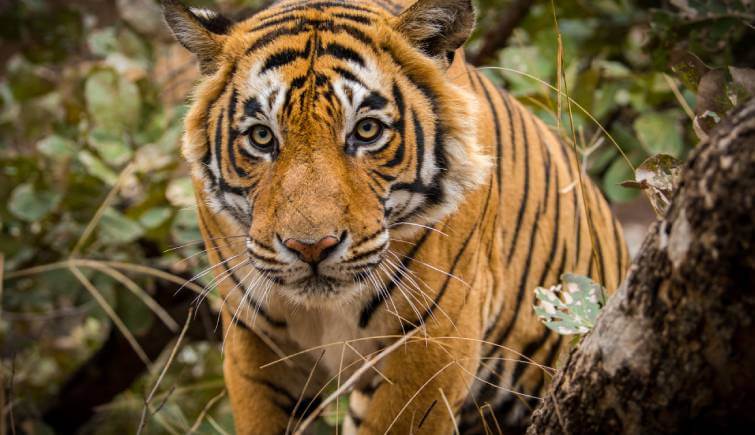

16 Feb, 2023
From benefit to threat: the effects of tourism on tiger conservation.
Tigers are one of the most magnificent and iconic animals on the planet. They are an apex predator, symbolising power, strength, and grace. However, tigers are also one of the most endangered species in the world, with only around 3,900 individuals left in the wild. Despite significant conservation efforts, the primary threat to tigers remains habitat loss, poaching, and the illegal wildlife trade. Tourism has emerged as a potentially powerful tool for tiger conservation, which is now particularly referred to as ‘Tiger Tourism.’ But it also has the potential to create new challenges and risks. In this blog, we will examine the positive and negative impacts of tourism on tiger conservation.
Before that, let’s discuss a little bit about tiger tourism and tiger conservation in the world, as well as in India.
Everything You Need to Know About Tiger Tourism
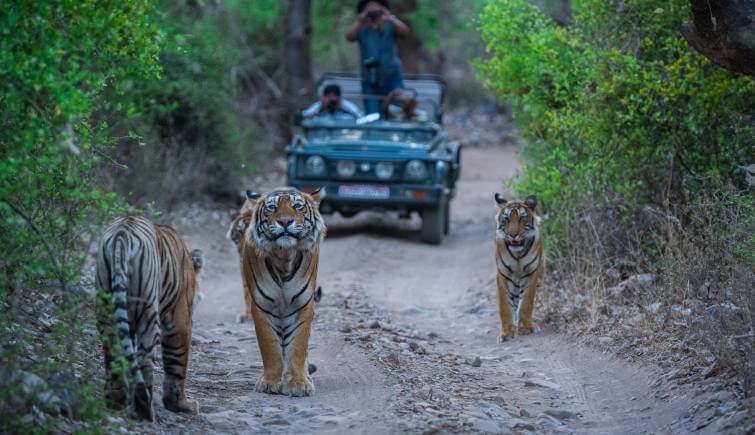
Tiger tourism refers to the practice of visiting national parks and wildlife sanctuaries that are home to wild tigers, with the primary goal of observing and experiencing the majestic animal in its natural habitat. The main purpose of tiger tourism is to promote conservation efforts and raise awareness about the endangered status of tigers.
Tiger tourism activities can take many forms, ranging from guided jeep safaris and walking tours to elephant-back rides and boat trips. Visitors may also stay in accommodations located within or near the protected areas, such as lodges and campsites. During these activities, tourists can encounter tigers in the wild and observe their behaviour, movements, and interactions with other animals in their natural habitat.
Tiger tourism can provide a source of income for local communities, which can help incentivize them to support conservation efforts for protecting tigers and their natural habitat. However, it is important to ensure that effects of tiger tourism activities are conducted in a responsible and sustainable manner, to minimise any negative impacts on the environment and the tigers themselves.
Now, What is Tiger Conservation?
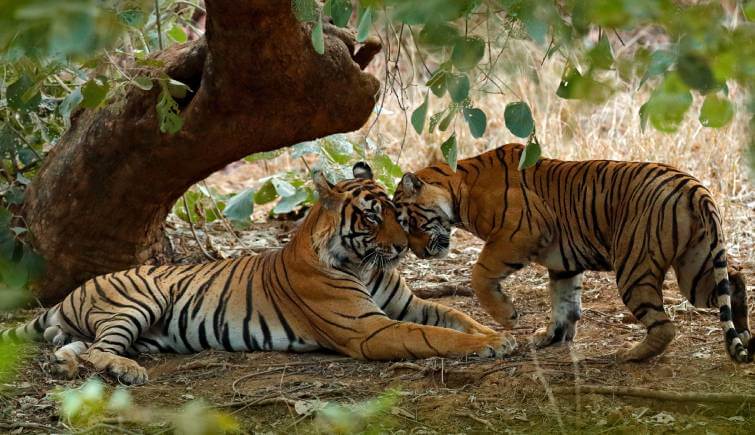
Tiger conservation is the set of efforts and strategies aimed at protecting wild tiger populations from the threats that endanger their survival. Tigers are considered to be one of the most iconic and charismatic species on the planet, but they are also one of the most endangered.
There are a number of threats to tiger populations, including habitat loss, poaching, and human-wildlife conflict. Tiger conservation efforts aim to address these threats and ensure that tiger populations can recover and thrive.
Some of the Key Components of Tiger Conservation Include:

Tigers need large areas of forest to live and hunt, so protecting and restoring their habitat is crucial to their survival.
Poaching is a major threat to tiger populations, as their bones, skin, and other body parts are highly valued in some traditional medicines and as luxury goods. Anti-poaching efforts involve monitoring tiger populations and cracking down on illegal wildlife trade.
As human populations grow and encroach on tiger habitat, conflicts between people and tigers can arise. Efforts to mitigate these conflicts can include measures such as relocating problem tigers or providing compensation to people who have lost livestock or crops to tigers.
Raising awareness about the importance of tiger conservation and the threats facing tiger populations is key to building support for conservation efforts.
Overall, tiger conservation is a complex and multi-faceted field that requires a range of strategies and approaches to be successful.
Let’s discuss about the importance of tourism for tiger conservation:
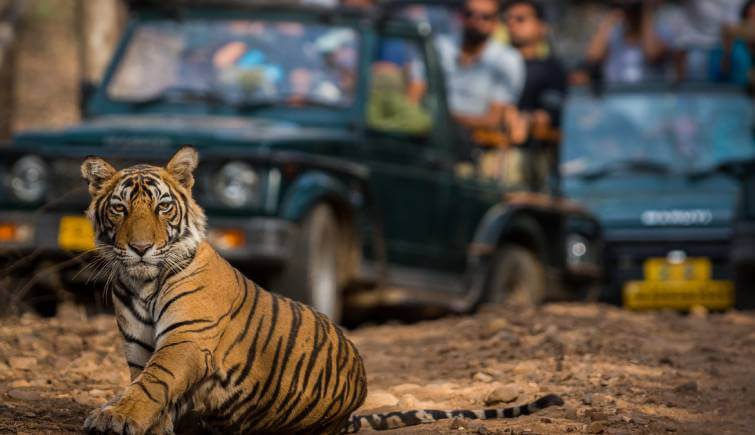
Tourism provides a source of revenue that can be used to fund conservation efforts such as anti-poaching patrols, habitat restoration or protecting forests and community-based conservation initiatives. Revenue generated from tourism can also help support the local economy and reduce reliance on unsustainable practices such as hunting and deforestation.
Tourism provides an opportunity for people to learn about tigers and their conservation. It can also foster a sense of connection and empathy, which may inspire people to take action for protecting tigers and protecting jungles.
Responsible ecotourism can create incentives for the conservation of tiger habitats by encouraging sustainable land use practices, such as community-based conservation and wildlife-friendly agriculture. Ecotourism can also provide an alternative livelihood for local communities that would otherwise rely on destructive practices like logging, poaching, or mining.
Tourism can generate political pressure for better policies and laws that protect tigers and their habitats. The international community can also apply pressure through boycotts or public pressure campaigns, as was the case with the boycott of tourism to Burma in the 1990s and early 2000s.
So, these are the positive impacts on tiger conservation. Now, the question comes, are there any negative impacts of tourism on tigers and other wildlife? The answer is yes. There are lots. Some of the important reasons are discussed below.
Negative Impacts of Tiger Tourism on Tiger Conservation:
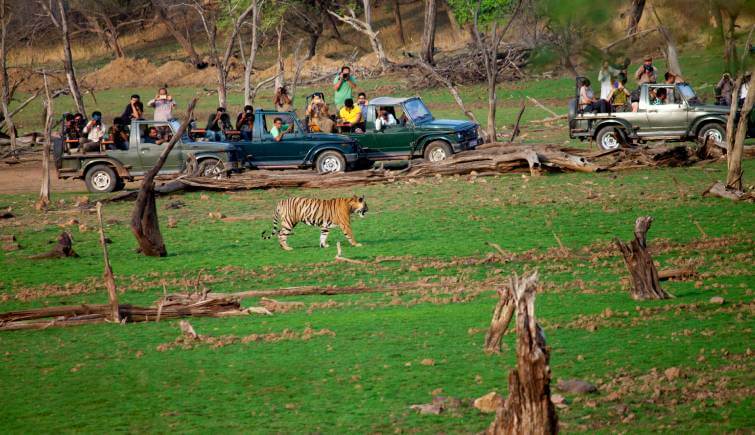
The presence of tourists can disrupt the natural behaviour of tigers, which may have negative consequences for their well-being. For example, tigers may spend more time hiding or avoiding tourist areas, which can affect their ability to hunt and mate. In some cases, the presence of tourists can also lead to aggressive behaviour towards humans or other animals.
The development of tourism infrastructure, such as roads, hotels, and trails, can lead to the fragmentation and degradation of tiger habitats. Habitat loss and fragmentation can increase the risk of inbreeding, reduce genetic diversity, and limit the availability of prey.
Tourism can also create opportunities for poachers and wildlife traffickers to operate. Tourists may unknowingly buy illegal wildlife products or participate in activities that are harmful to tigers, such as posing for photos with captive tigers or attending tiger shows. The demand for these activities and products can fuel poaching and the illegal wildlife trade.
Tourism can create conflicts between tourists and local communities, particularly if the benefits of tourism are not equitably distributed. Local communities may also face environmental impacts such as pollution and habitat degradation, which can affect their livelihoods and well-being.
Tourism can be a powerful tool for tiger conservation, but it must be managed responsibly to ensure that it does not have negative impacts on tigers, their habitats, or local communities. The tiger and tourism debate can go on for centuries like that, but it is also important to remember that responsible ecotourism can provide a sustainable source of income for local communities while also promoting the conservation of tigers and their habitats. To maximise the positive impact of tourism on tiger conservation, it is important to work with local communities and stakeholders to develop and implement sustainable tourism practices that prioritise the long-term health of tigers and their habitats.
- Writer- Nandini
- Photo Credits: Shutter Stock
Frequently Asked Questions
What is the impact of tourism on tiger conservation.
There are positive as well as negative impacts of tourism on tiger conservation. Some of the positive impacts are financial benefits for conservation efforts, sustainable ecotourism, awareness of tiger conservation, whereas some of the negative impacts are disturbance of wildlife behaviour, habitat destruction, etc.
How does responsible tourism benefit tiger conservation?
Responsible tourism can create incentives for the conservation of tiger habitats by encouraging sustainable land use practices, such as community-based conservation and wildlife-friendly agriculture.
Can tourism generate funding for tiger conservation?
How does tourism affect the habitat of tigers, does increased tourism result in the displacement of tigers.
Yes, increased tourism means more development which results in the development of roads, hotels and other related things. It degrades the natural habitat for tigers and other wildlife and displacement of tigers.
Can tourism lead to the destruction of tiger habitats?
Limited tourism does not affect the tiger habitats but increased limit of tiger tourism leads to the destruction of tiger habitats.
Does increased tourism lead to an increase in tiger poaching?
Tourism can also create opportunities for poachers and wildlife traffickers to operate. Tourists may unknowingly buy illegal wildlife products or participate in activities that are harmful to tigers, such as posing for photos with captive tigers or attending tiger shows.
Does increased tourism lead to an increase in human-tiger conflicts?
The presence of tourists can also lead to aggressive behaviour towards humans or other animals. Increased tourism can disrupt their lifestyle which leads to an increase in human-tiger conflicts.
How can responsible tourism practices be promoted to ensure the positive impact of tourism on tiger conservation?
Responsible tourism practices can play an important role in promoting the positive impact of tourism on tiger conservation. Encouraging tourists to participate in ecotourism activities can help promote responsible tourism practices that benefit tiger conservation. Tourism operators should follow tiger-friendly tourism practices that minimise disturbance to tigers, protect their habitat, and avoid direct contact with them. Tourists should be educated on tiger conservation and how their tourism activities can help or harm tiger populations. Tourists should be informed about responsible tourism practices and how they can contribute to tiger conservation. Overall, promoting responsible tourism practices that benefit tiger conservation requires a multi-stakeholder approach that involves tourists, tourism operators, local communities, and conservation organisations. By working together, we can ensure that tourism has a positive impact on tiger conservation and helps protect this iconic species for future generations.
Should the number of tourists be controlled to ensure the positive impact of tourism on tiger conservation?
Controlling the number of tourists can be one approach to ensure the positive impact of tourism on tiger conservation, but it may not be the only solution or the most effective one. Tourism can be an important source of income and employment for local communities, and it can help raise awareness and support for tiger conservation efforts. However, uncontrolled tourism can also have negative impacts on tiger habitats and populations, such as disturbing their natural behaviour, causing stress and disease, and damaging their habitat. Controlling the number of tourists can be one part of a larger strategy to ensure the positive impact of tourism on tiger conservation, but it should be considered in the context of broader efforts to promote responsible and sustainable tourism practices and address the underlying drivers of tiger habitat loss and poaching.
Explore Popular Ranthambore Wildlife Tour Packages
- Information Trinetra Ganesh Temple Ranthambore
- Ranthambore National Parks Latest News Updates
- Best Luxury Resorts in Ranthambore National Park
- Peacock Flying in Ranthambore National Park
- Take a Jungle Safari at These 10 Best Wildlife Destinations in Summer Season & Get the Best of Wildlife Adventure
- The Inspiring Story of How Aditya & Poonam Singh Made a Lush Forest Out of a Barren Land in Ranthambore
- Why Should We be Teaching Wildlife Conservation in Schools?
- Do’s and Don’ts of Staying Safe Around Wildlife
- Human – Wildlife Conflict in Concrete Jungle
- 20 Facts You Probably Didn’t Knew About Tigers
- Wildlife Conservation Initiatives by Indian Government
- Experience Golden Triangle India with Ranthambore Tiger Safari
- 10 Reasons to Visit Ranthambore Tiger Reserve in Rajasthan
- In Pictures: Showcasing India’s Endangered Species
- My Experience at Ranthambore National Park- Sundeep Kheria
- Top 5 Star Hotels in Ranthambore Tiger Reserve
- Photography Tour in Ranthambore National Park
- Rajiv Gandhi Regional Museum of Natural History
Popular Posts

20 Facts You Probably Didn’t Knew About Tige...

Wildlife Conservation Initiatives by Indian Govern...
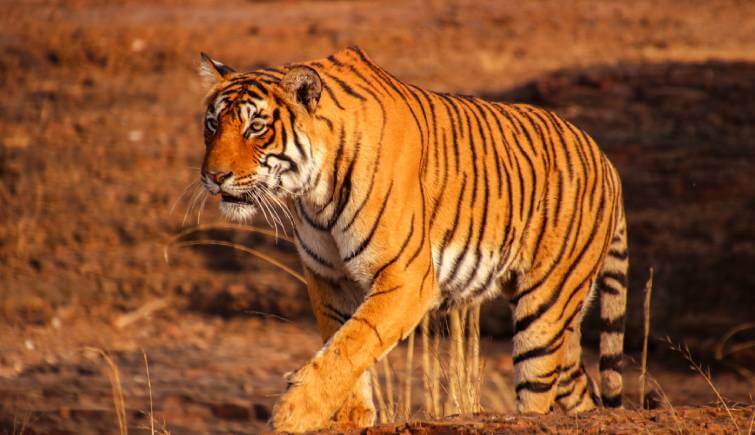
Top 5 National Parks for Guaranteed Tiger Sighting...
Recent Posts
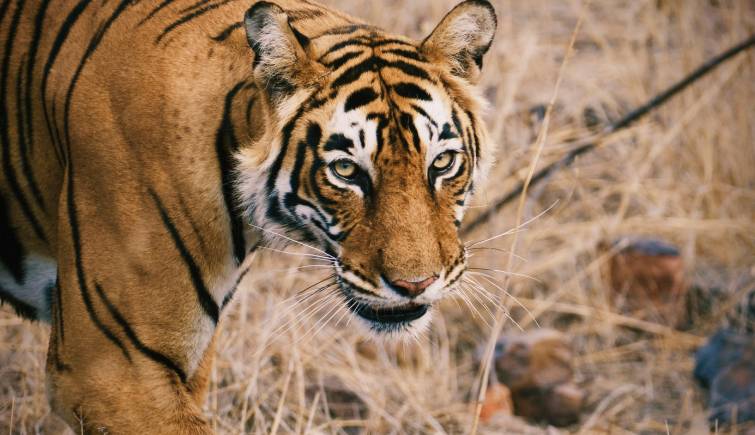
Singapore Mission Official Spots Tigress ‘Sh...
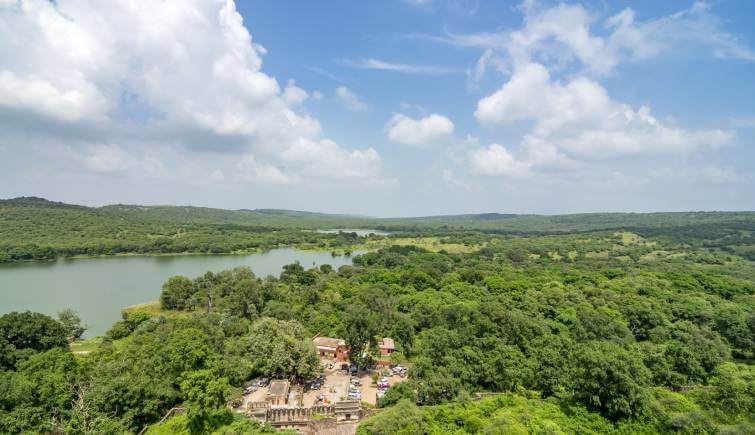
6 Best Wildlife & Nature Weekend Destinations...

Gujarat Titans Visit at Ranthambore National Park...
Select Country Afghanistan Albania Algeria American Samoa Andorra Angola Anguilla Antigua and Barbuda Argentina Armenia Armenia Aruba Australia Austria Azerbaijan Azerbaijan Bahamas Bahrain Bangladesh Barbados Belarus Belgium Belize Benin Bermuda Bhutan Bolivia Bonaire Bosnia and Herzegovina Botswana Bouvet Island (Bouvetoya) Brazil British Indian Ocean Territory (Chagos Archipelago) British Virgin Islands Brunei Darussalam Bulgaria Burkina Faso Burundi Canada Cambodia Cameroon Cape Verde Cayman Islands Central African Republic Chad Chile China Christmas Island Cocos (Keeling) Islands Colombia Comoros Congo Congo Cook Islands Costa Rica Cote d'Ivoire Croatia Cuba Curaçao Cyprus Cyprus Czech Republic Denmark Djibouti Dominica Dominican Republic Ecuador Egypt El Salvador Equatorial Guinea Eritrea Estonia Ethiopia Falkland Islands (Malvinas) Faroe Islands Fiji Finland France French Guiana French Polynesia French Southern Territories Gabon Gambia Georgia Georgia Germany Ghana Gibraltar Greece Greenland Grenada Guadeloupe Guam Guatemala Guernsey Guinea Guinea-Bissau Guyana Haiti Heard Island and McDonald Islands Holy See (Vatican City State) Honduras Hong Kong Hungary Iceland India Indonesia Iran Iraq Ireland Isle of Man Israel Italy Jamaica Japan Jersey Jordan Kazakhstan Kazakhstan Kenya Kiribati Korea Korea Kuwait Kyrgyz Republic Lao People's Democratic Republic Latvia Lebanon Lesotho Liberia Libyan Arab Jamahiriya Liechtenstein Lithuania Luxembourg Macao Macedonia Madagascar Malawi Malaysia Maldives Mali Malta Marshall Islands Martinique Mauritania Mauritius Mayotte Mexico Micronesia Moldova Monaco Mongolia Montenegro Montserrat Morocco Mozambique Myanmar Namibia Nauru Nepal Netherlands Netherlands Antilles New Caledonia New Zealand Nicaragua Niger Nigeria Niue Norfolk Island Northern Mariana Islands Norway Oman Pakistan Palau Palestinian Territory Panama Papua New Guinea Paraguay Peru Philippines Pitcairn Islands Poland Portugal Puerto Rico Qatar Reunion Romania Russian Federation Rwanda Saint Barthelemy Saint Helena Saint Kitts and Nevis Saint Lucia Saint Martin Saint Pierre and Miquelon Saint Vincent and the Grenadines Samoa San Marino Sao Tome and Principe Saudi Arabia Senegal Serbia Seychelles Sierra Leone Singapore Sint Maarten (Netherlands) Slovakia (Slovak Republic) Slovenia Solomon Islands Somalia South Africa South Georgia & S. Sandwich Islands Spain Sri Lanka Sudan Suriname Svalbard & Jan Mayen Islands Swaziland Sweden Switzerland Syrian Arab Republic Taiwan Tajikistan Tanzania Thailand Timor-Leste Togo Tokelau Tonga Trinidad and Tobago Tunisia Turkey Turkey Turkmenistan Turks and Caicos Islands Tuvalu U.S. Virgin Islands U.S. Minor Outlying Islands Uganda Ukraine United Arab Emirates United Kingdom United States Uruguay Uzbekistan Vanuatu Venezuela Vietnam Wallis and Futuna Western Sahara Yemen Zambia Zimbabwe
Useful Links
- Safari Timing
- Safari Booking
- Holiday Packages
- Famous Tiger Story
- Tiger Special Tours
- Tiger Trails India
- Bird Watching Tours
- Golden Triangle with Tigers
- Golden Triangle with Ranthambore
- Ranthambore Weekend Package
- Taj Mahal and Ranthambore Tour
- Ranthambore Corbett Tour with Agra
- Ranthambore Park Special Package
Our Sales Office
C-81C, Sector-8, Noida
+91-120-4052615-99(85 hunting lines are available)
Connect with Us

Ranthambore National Park. All rights reserved. © 2024
- We Accept :

Arrival Date
Departure Date
Country —Please choose an option— Afghanistan Albania Algeria American Samoa Andorra Angola Anguilla Antigua and Barbuda Argentina Armenia Armenia Aruba Australia Austria Azerbaijan Azerbaijan Bahamas Bahrain Bangladesh Barbados Belarus Belgium Belize Benin Bermuda Bhutan Bolivia Bonaire Bosnia and Herzegovina Botswana Bouvet Island (Bouvetoya) Brazil British Indian Ocean Territory (Chagos Archipelago) British Virgin Islands Brunei Darussalam Bulgaria Burkina Faso Burundi Canada Cambodia Cameroon Cape Verde Cayman Islands Central African Republic Chad Chile China Christmas Island Cocos (Keeling) Islands Colombia Comoros Congo Congo Cook Islands Costa Rica Cote d'Ivoire Croatia Cuba Curaçao Cyprus Cyprus Czech Republic Denmark Djibouti Dominica Dominican Republic Ecuador Egypt El Salvador Equatorial Guinea Eritrea Estonia Ethiopia Falkland Islands (Malvinas) Faroe Islands Fiji Finland France French Guiana French Polynesia French Southern Territories Gabon Gambia Georgia Georgia Germany Ghana Gibraltar Greece Greenland Grenada Guadeloupe Guam Guatemala Guernsey Guinea Guinea-Bissau Guyana Haiti Heard Island and McDonald Islands Holy See (Vatican City State) Honduras Hong Kong Hungary Iceland India Indonesia Iran Iraq Ireland Isle of Man Israel Italy Jamaica Japan Jersey Jordan Kazakhstan Kazakhstan Kenya Kiribati Korea Korea Kuwait Kyrgyz Republic Lao People's Democratic Republic Latvia Lebanon Lesotho Liberia Libyan Arab Jamahiriya Liechtenstein Lithuania Luxembourg Macao Macedonia Madagascar Malawi Malaysia Maldives Mali Malta Marshall Islands Martinique Mauritania Mauritius Mayotte Mexico Micronesia Moldova Monaco Mongolia Montenegro Montserrat Morocco Mozambique Myanmar Namibia Nauru Nepal Netherlands Netherlands Antilles New Caledonia New Zealand Nicaragua Niger Nigeria Niue Norfolk Island Northern Mariana Islands Norway Oman Pakistan Palau Palestinian Territory Panama Papua New Guinea Paraguay Peru Philippines Pitcairn Islands Poland Portugal Puerto Rico Qatar Reunion Romania Russian Federation Rwanda Saint Barthelemy Saint Helena Saint Kitts and Nevis Saint Lucia Saint Martin Saint Pierre and Miquelon Saint Vincent and the Grenadines Samoa San Marino Sao Tome and Principe Saudi Arabia Senegal Serbia Seychelles Sierra Leone Singapore Sint Maarten (Netherlands) Slovakia (Slovak Republic) Slovenia Solomon Islands Somalia South Africa South Georgia & S. Sandwich Islands Spain Sri Lanka Sudan Suriname Svalbard & Jan Mayen Islands Swaziland Sweden Switzerland Syrian Arab Republic Taiwan Tajikistan Tanzania Thailand Timor-Leste Togo Tokelau Tonga Trinidad and Tobago Tunisia Turkey Turkey Turkmenistan Turks and Caicos Islands Tuvalu U.S. Virgin Islands U.S. Minor Outlying Islands Uganda Ukraine United Arab Emirates United Kingdom United States Uruguay Uzbekistan Vanuatu Venezuela Vietnam Wallis and Futuna Western Sahara Yemen Zambia Zimbabwe
No of Person


- Post author: Kylie Hubbard
- Post published: May 18, 2021
When you think of tiger tourism, you might remember the release of Tiger King last March. If you remember anything from the show, it might be Joe Exotic and his countless attempts to obtain and profit from big cats, including tigers. The conservation and animal welfare issues with Joe Exotic’s Greater Wynnewood Exotic Animal Park weren’t really shown in the Netflix original series.
That’s right, petting tigers and taking selfies with them might make you happy and possibly up your Tinder profile, but the damage to these big cats and the conservation of this endangered species could be irreversible. If you’re wondering how you can help and still observe tigers ethically, I’ve broken it all down here.
About tigers
First, it’s important to remember that tigers aren’t actually snuggly animals in the wild like they appear to be in captivity. They are solitary animals, which unfortunately makes them a big gain for hunters looking for a trophy or to sell on the black market as body parts for traditional Chinese medicine. They’re elusive and scarce, making a sighting a lot more prized.
Tigers are also massive and the largest of all Asian big cats. There are around 3,900 tigers left in the world, according to the latest census. Female tigers give birth to two to four cubs every two years.
This post may contain affiliate links. Please see our disclosure .
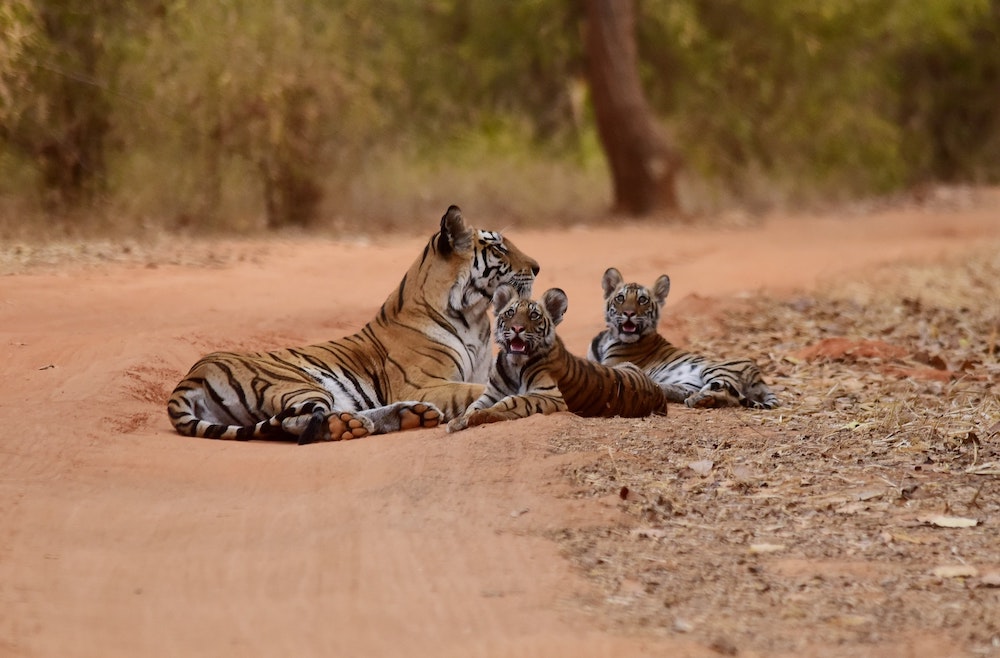
Tiger subspecies
Before the 20th century, there were 8 subspecies of tiger. Three became extinct during the 20th century, and the five remaining subspecies are at risk.
- Bengal : Sometimes called Indian tigers, Bengal tigers are the most common tiger and make up about half of all the wild tiger population. Over the centuries, Bengal tigers have become an important part of Indian tradition and lore. On average, a Bengal tiger lives to be 8 to 10 years old and can weigh on average up to 500 pounds.
- Indochinese : This subspecies of tigers are also known as “Corbett Tiger” and inhabit a small region of Southeast Asia. In 2004, the Indochinese tiger was split from the Malayan tiger and considered a different subspecies. It’s a relatively small species and has a darker orange coat with narrower dark stripes.
- Sumatran : It’s estimated that less than 400 Sumatran tigers are left in the wild today. Distinguished by their heavy black stripes, their rapid population decline is caused by accelerated deforestation and rampant poaching. While all tiger subspecies are at risk, Sumatran tigers are critically endangered.
- Siberian : These giant tigers are the world’s largest cats. Siberian tigers live primarily in Eastern Russia in the birch forests, but some can be found in China and North Korea. Siberian tigers can weigh up to 700 pounds.
- Malayan : These tigers are the most recently recognized subspecies of tigers and are the national animal of Malaysia. Malayan tigers were split from the Indochinese tiger subspecies in 2004. There is limited information about Malayan tigers, but they are thought to be smaller than the tigers living in India.
Quick look at tigers
- Lifespan — In the wild, tigers live on average to be between 8 and 10 years old. Historically, tigers live longer in captivity, with lifespans of 14 to 16 years. The oldest tiger in history was named Flavio. Flavio was rescued from 13 years of doing circus shows, and he lived to the age of 25 years old in captivity. But, do not equate longer life to mean better quality of life. Captivity eliminates natural causes of death for the most part.
- Weight — As you might expect, males tend to be larger and females smaller when it comes to tiger weight. On average, tigers weigh between 150 and 700 pounds. The largest tiger on record is an 845-pound Siberian.
- Diet — Tigers are carnivores and eat mostly large prey like deer, wild boar, and even elephant calves. They take down their prey by lunging at the animal’s neck and holding on tight with their powerful jaws.
- Conservation status — Each subspecies of tiger is at risk, classified as endangered on the Red List of Threatened Species published by the International Union for Conservation of Nature.
About tiger habitats
Tigers can be found in a diverse array of habitats, including rainforests, grasslands, savannas, and mangrove swamps. But, the habitats available to tigers are diminishing, with about 93% of historical tiger lands having disappeared . Land once inhabited by tigers has been diminished due to the expansion of human activity.
Fun facts about tigers
- Tigers are the largest felines in the world amongst wild cats. They’re also the third largest carnivore on land behind polar bears and black bears.
- Tigers are nocturnal creatures and are often solitary.
- Tiger cubs are born blind, relying on their mother for at least a few weeks as a newborn. Female cubs are the sole provider for cubs until up to two years after birth.
- While tigers are solitary, they are also playful. You can see them scum and play in the water.
- Tigers can sprint up to 60 kilometers per hour and can climb trees, although they seldom do.
- Tigers can roar, but they do not purr.
- No two tigers have the same stripes. Just like our fingerprints or a snowflake’s design, each is unique.
- A tiger’s tail is about 3 feet long and helps them maintain balance.
- The big padded paws of tigers make it easier for them to silently sneak up on prey.
Why are tigers endangered?
The four biggest threats that endanger the tiger species include poaching, hunting, tourism and palm oil.
- Poaching — While the tiger has long been hailed in Indian and Chinese lore, Traditional Chinese Medicine has kept the illegal trade of tiger bones and body parts vibrant. In addition to illegally trading body parts, the skin of tigers is highly profitable for poachers, making the thrill of catching a tiger more enticing with a high price tag.
- Hunting — While poaching is hunting, there is another level to hunting tigers. Many big game hunting enthusiasts see big carnivores like tigers as a “bucket list kill.”
- Tourism — By visiting places that have tigers available for petting and selfies, you are directly supporting these tourist traps indirectly supporting the speed breed of tigers. Female tigers in these situations are forced to breed more frequently than in the wild, by having their cubs removed from their care right after birth. This speeds up the gestation period in females.
- Palm oil — 90% of Sumatran tiger habitat has been lost thanks to palm oil plantations. You can stop this spread by not purchasing palm oil and speaking out about the damage the rapidly growing industry is causing to tiger habitat and the rainforest as a whole.
Common tiger tourism activities
There are two main tiger tourism activities: petting tigers and tiger selfies. Both of these are extremely damaging to tiger conservation.
Petting tigers
In most cases, the tigers used for petting experiences are cubs that have been speed bred and removed from their mothers too soon. The constant flashing of camera lights can cause early cataracts in early developing eyes, and human interaction can also expose cubs to diseases. Young tigers often sleep during the day in the wild but often miss that chance in captivity. Usually nocturnal in the wild, they are forced to sleep in the evening. Once they grow past the age of petting, they are often sold on the black market for parts.
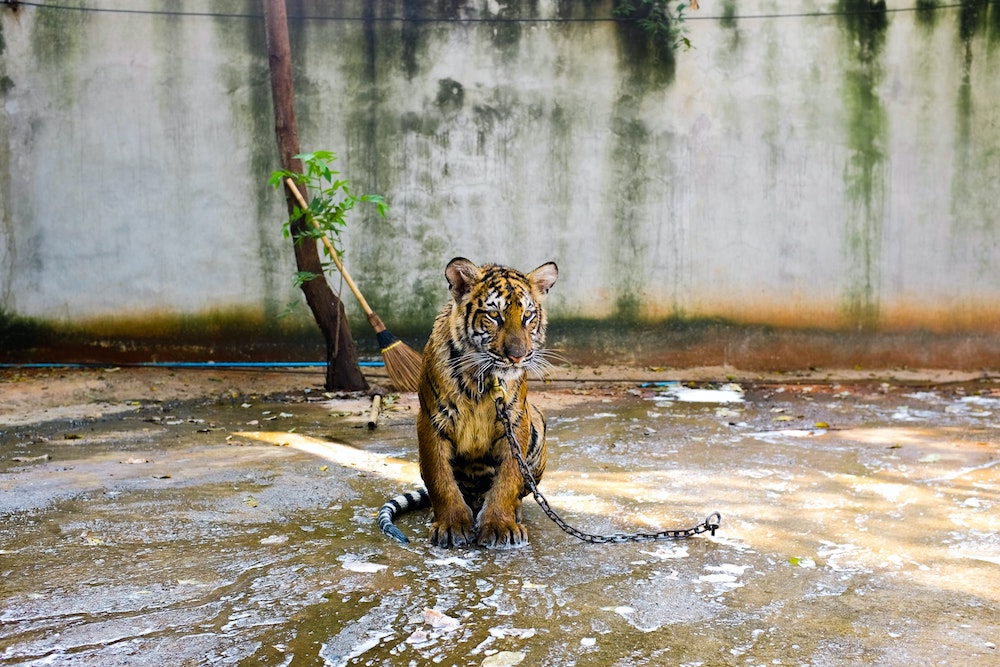
Tiger selfies
Remember when a bunch of men started using photos of them with tigers in their Tinder profiles? Yeah, that’s not cool. Most, if not all, of the photos taken like this are taken with a tiger that has been drugged to sit still. And when the tiger isn’t putting on a show for the selfie, it is caged alone.
Not only is a tiger selfie intentionally supporting this behavior from handlers, but also encourages the mistreatment of animals and implies that they only exist to serve humans’ entertainment.
Tiger tourism – where to see tigers in the wild
Tigers can be found in swamps, grasslands, and rainforests, meaning you can see a tiger in the wild in a variety of countries. From the Russian Far East to parts of North Korea, China, India, and Southwest Asia to the Indonesian island of Sumatra, there’s a chance you could see a tiger or two.
Madhya Pradesh, India
Madhya Pradesh is known as India’s “Tiger State” and is one of the 50 reserves in the country. There is one walking safari, the Satpura reserve, and all other safaris are conducted in Maruti Suzuki Gypsies (or Jeeps). You can book a safari ride for morning, afternoon and sometimes evening with the right local guide.
It’s suggested that you take at least four rides for the best chance to see a tiger. But, even if you don’t catch a tiger, there’s a good chance you’ll see other wildlife like deer, owls, eagles, gaur, langurs, macaques and if you’re lucky, a sloth or jungle cat.
For the most luck spotting a tiger, visit during the pre-monsoon months of April and May.
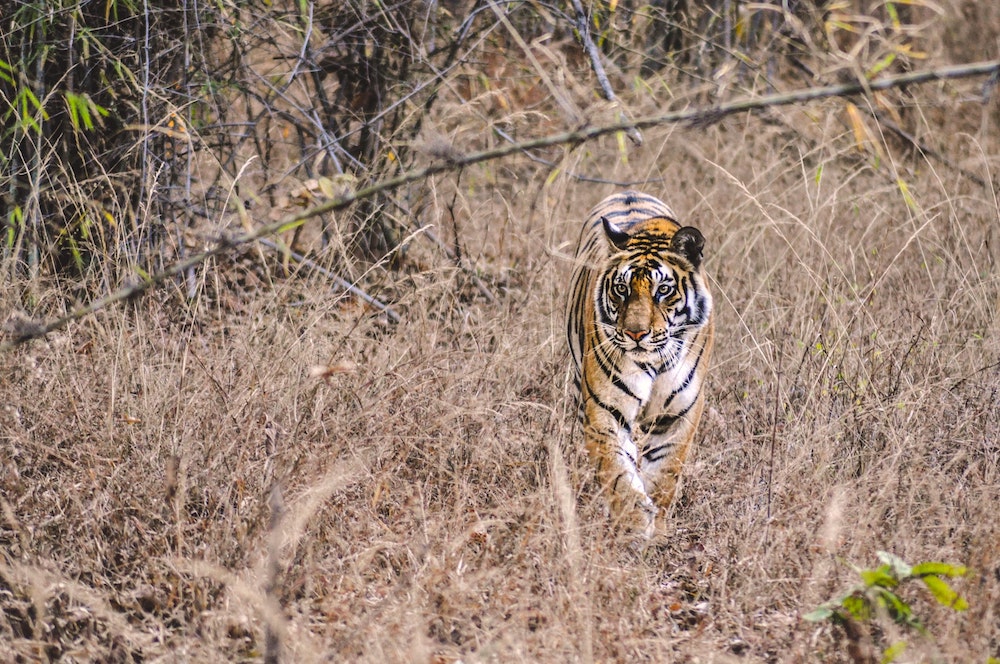
Barcadia National Park, Nepal
The Barcadia National Park is located in the remote northwest of Nepal, and it’s the best spot to see one of the 80-odd tigers that call it home. Each lodge in the national park offers walking and 4WD safaris and while you can cover more ground riding around, you experience intimate wildlife viewings by walking.
In addition to the chance of seeing a tiger, you can also see rhinos, otters, crocodiles, wild elephants and five species of deer.
Although the Barcadia National Park is open year-round, the best times to see them would be the hot season by the river.
The Sundarbans, Bangladesh
The Sundarbans straddle India and Bangladesh and is the world’s largest mangrove forest. Although both sides are an adventure, The Sundarbans is better accessed from the Bangladesh side, where you’ll find deeper access and maximize your chance of seeing a tiger.
To get to The Sundarbans, you hop aboard a multi-day boat tour from Khulna. Eating and sleeping occurs on the main tour boat, but you break into smaller groups and track tigers on foot or by smaller boats.
You’re most likely to spot a tiger in April and May, even though visiting in October through March may be more comfortable. In addition to tigers, you can also spot saltwater crocodiles, wild boar, langurs and many of the 260 bird species in the region.
Durminskoye Reserve, Russia
The Siberian tiger is found primarily in eastern Russia and northern China. Russia became the first country to grant full protection of tigers in 1965, and that act saved them from extinction.
The chance of spotting a tiger is pretty rare, though, and most tours are run like citizen science projects where guests spend their days tracking pug marks and snowmobiles and on foot. While tracking pug marks, you’ll set camera traps and review footage, all in contribution to the protection of the species.
In addition to the slim chance of seeing tigers, you can also see wolves, lynx, badgers, foxes and raptors, and in the summer you may even see an Asian black bear.
For the best conditions to track tigers, visit during the month of November through February.
Ranthambore National Park, Rajasthan, India
Ranthambore National Park is 154 square miles of space where tigers can be found roaming freely through the park. The park is composed of dry deciduous forest, brushland, rocky hills and some of the most beautiful ancient structures.
A fixed number of vehicles are permitted in the park for tracking both morning and afternoon. 40 gypsies and open-sided canters embark on tracking sessions each day. In addition to seeing tigers on the drives, you can also see deer, wild pigs, peacocks, leopards and sloth bears.
The peak months to visit are between October and December.
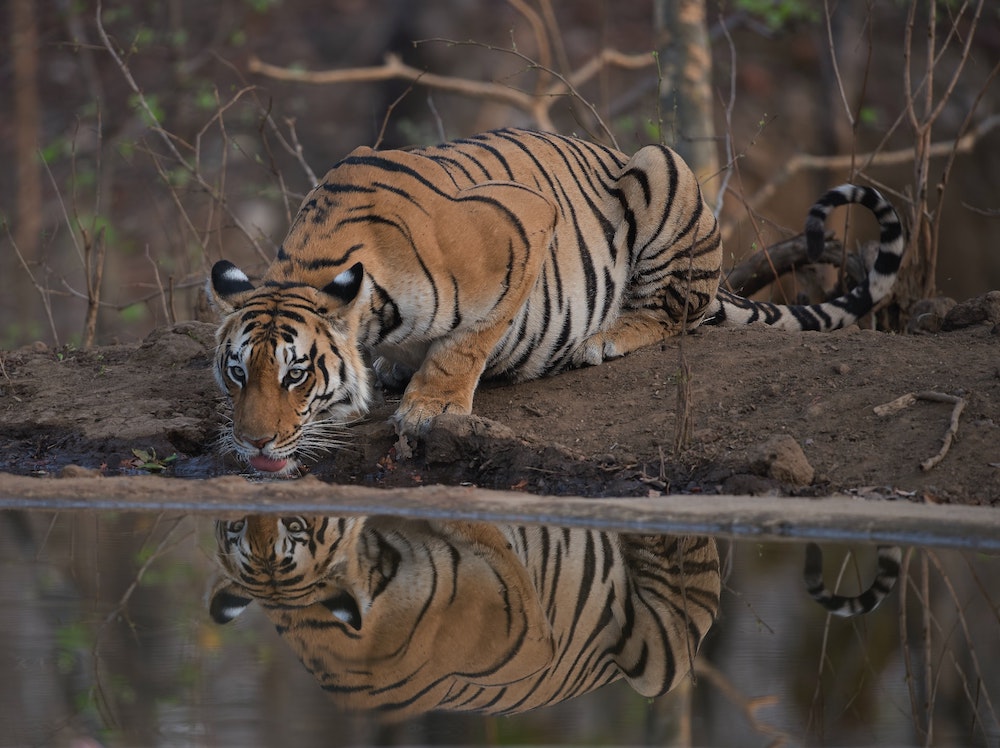
Kerinci Seblat National Park, Sumatra, Indonesia
Kerinci Seblat National Park is the largest national park in Sumatra and has some of the healthiest populations of Indonesian wildlife like elephants, bears, tapirs, clouded leopards, gibbons and more tigers than can be found in all of Indonesia.
But, it won’t be easy to spot a tiger. Many visitors to the national park embark on the climb to Gunung Kerinci, which is the highest active volcano in Southeast Asia. You might see a tiger on your climb if you’re lucky, but do know it’s rare.
Chitwan National Park, Chitwan, Nepal
Chitwan National Park was the first national park in Nepal when it was founded in 1973. Before it was a national park, Chitwan was prime hunting grounds. Talk about a glow up.
In 1984 it became a UNESCO World Heritage Site and is currently protected by the Nepali Army.
You can hop on a jungle safari or join a jungle walk for a chance to see a tiger in the wild. In addition, you could see wildlife like birds, deer, rhinos, crocodiles and monkeys.
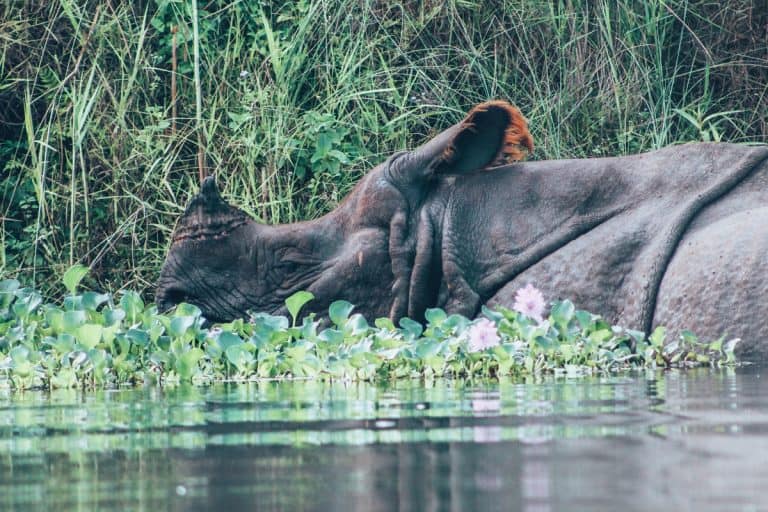
How to help tigers
- The Deer And The Tiger by George Schaller
- Just Tigers by Jim Corbett
- Tigers Forever: Saving the World’s Most Endangered Cat by Steve Winter
- Living With Tigers by Valmik Thapar
- A Decade With Tigers: Supremacy. Solitude. Stripes by Shivang Mehta
- Tiger Matters
- The Tiger Who Crossed the Line
- Download a Palm Oil app to make sure the items you’re purchasing use only sustainable palm oil.
- Spread the word to others!
- Support ethical wildlife sanctuaries , true conservation organizations, and the national parks that these wonderful big cats call home.
- Recent Posts
- 8 of the Best Hikes near Gatlinburg for All Skill Levels and Seasons - November 5, 2023
- 16 Sustainable Swimwear Brands to Check Out This Summer - June 14, 2023
- The Best Shark Gifts for the Shark Enthusiasts - September 7, 2022
You Might Also Like

9 Weird Things To Do In Dublin, Ireland

Places To Visit In Dorset | Don’t Forget this English County

Five Unique and Free Things to Do in St Louis
Leave a reply cancel reply.

- Privacy Overview
- Strictly Necessary Cookies
This website uses cookies so that we can provide you with the best user experience possible. Cookie information is stored in your browser and performs functions such as recognising you when you return to our website and helping our team to understand which sections of the website you find most interesting and useful.
Strictly Necessary Cookie should be enabled at all times so that we can save your preferences for cookie settings.
If you disable this cookie, we will not be able to save your preferences. This means that every time you visit this website you will need to enable or disable cookies again.
2022 is the Year of the Tiger: Here are 15 places to see them ethically in the wild
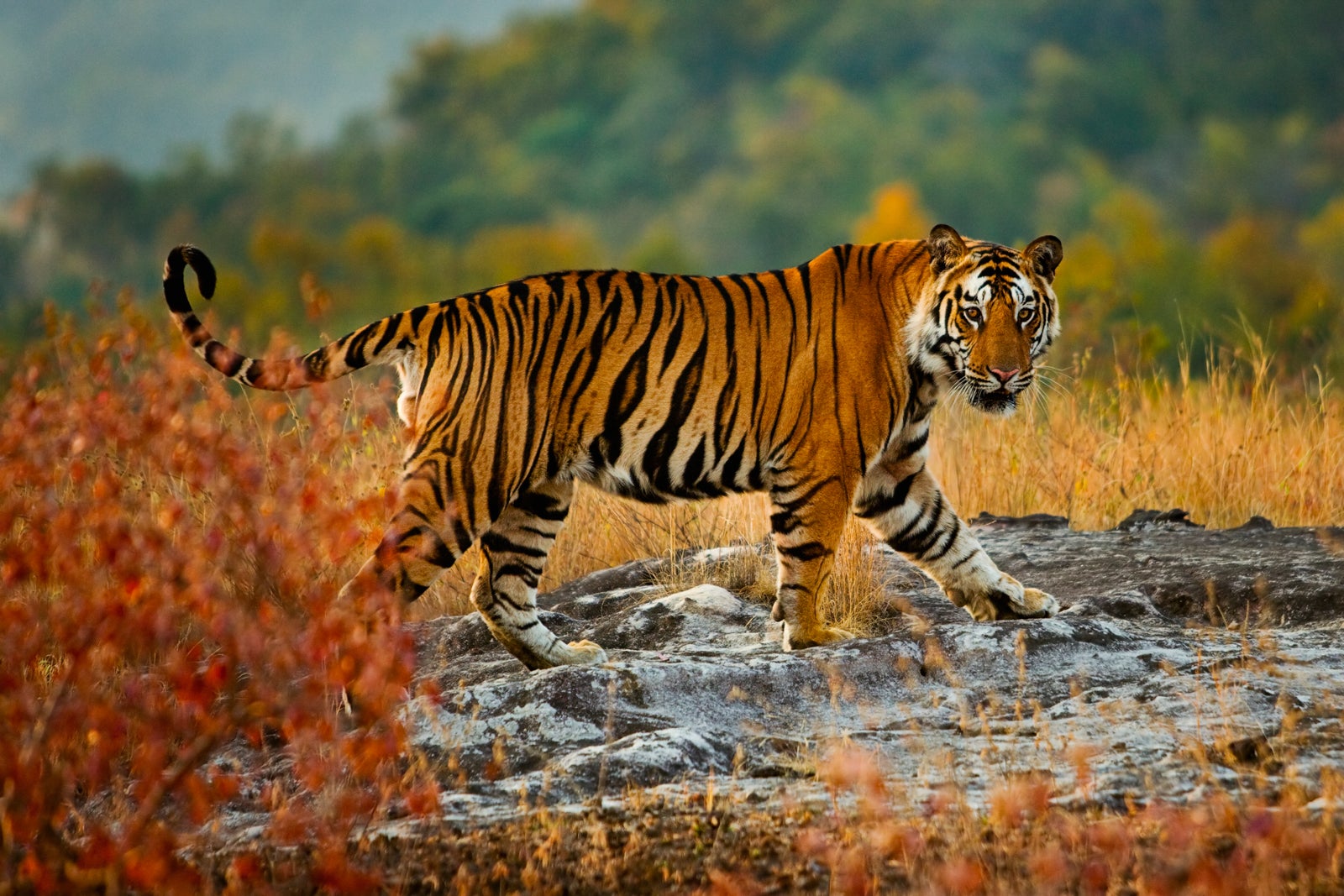
With the Tiger King, Joe Exotic, currently serving a 22-year sentence for murder for hire and animal abuse, and fewer than 3,900 tigers left in the wild worldwide, tiger tourism is at a crossroads. Those who dream of seeing these gracious and elegant cats in their natural habitat are more motivated than ever, while the world's consciousness has been raised about what constitutes humane treatment of one of the most revered species on Earth.
There's no time like the present to see them -- especially since the Year of the Tiger in the Chinese lunar calendar begins on Feb. 1, 2022.
Of all the big cat species, tigers have perhaps been the most drastically affected by a host of issues, from hunting and poaching to climate change and loss of habitat, with the result being that three of the original nine tiger subspecies are already extinct.
Of the six subspecies remaining, two -- the Sumatran and South China -- are now listed as critically endangered. In fact, no South China tiger has been seen in the wild in more than two decades and fewer than 100 remain in zoos.
Want more travel news and advice? Sign up for TPG's daily newsletter .
While it's tempting to want to visit tigers in private wildlife preserves like the now-closed facility featured in the "Tiger King" documentary, it's important to understand that by doing so you're supporting a poorly regulated industry where animals are frequently subject to abuse.
When considering a visit to any zoo, check that it has been accredited by the Association of Zoos and Aquariums , which requires that zoos meet strict qualifications for best practices regarding quality of habitat, cleanliness and veterinary care, and also participate in worldwide conservation initiatives.
"Outside of safaris in national parks located in South Asia and Russia, there is simply no truly ethical way to see a tiger. While tigers in major metropolitan zoos are well cared for, and often arrive as rescue animals, the same can't be said of most so-called rescue habitats or exotic animal parks, much less tiger encounter experiences in Asia," says Jeff Greenwald, executive director of Ethical Traveler, a nonprofit organization which seeks to use the economic benefits of tourism to protect human rights and the environment.
Noting examples such as the Thai Buddhist petting temple, which lost more than half of its 147 tigers to a virus, Greenwald says it's important to support only the zoos and other highly respected and rated institutions recognized for providing high-quality care. "If you are compelled to see a live tiger and can't afford a big trip to India, Nepal or Russia, see one in a legitimate zoo – like the Bronx or San Diego Zoo," says Greenwald. "Otherwise, ask yourself: Am I willing to have a tiger captured, drugged or caged so that I can take a picture of it?"
There are bright spots, though, in the midst of this darker reality, with the numbers of Bengal and Siberian tigers both increasing over the past decade. Along with those rising numbers have come numerous positive developments in tiger tourism, including better regulation and infrastructure improvements in several of the world's best tiger habitats. The result: Visitors have a better chance of seeing — and photographing — a tiger, without causing harm in the process.
Here, then, are 15 of the best — and most ethical — places to see tigers in the wild.
1. Bandhavgarh National Park, Madhya Pradesh, India
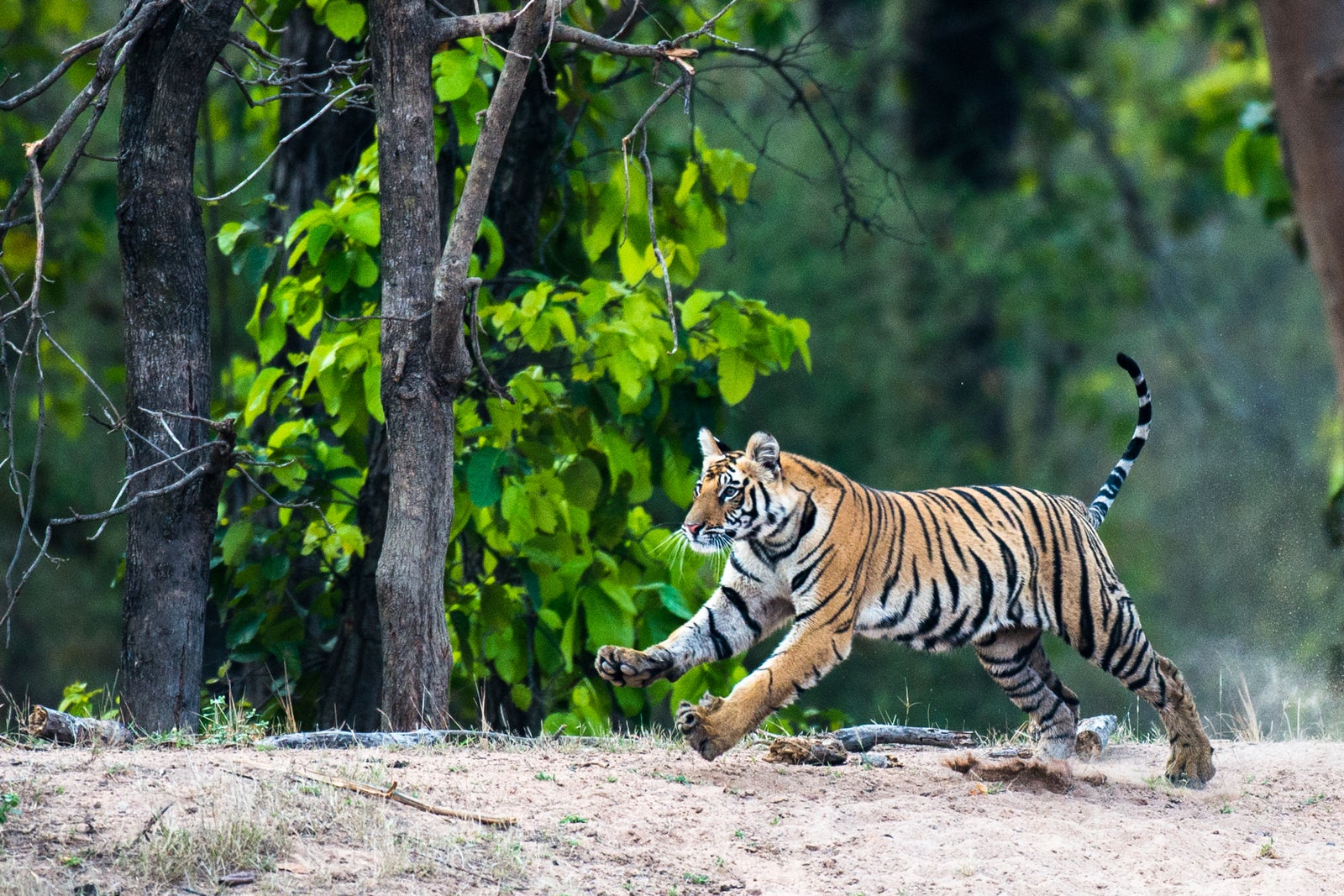
Known as India's "Tiger State," Madhya Pradesh is home to more than 70% of the world's wild tigers, making the state a magnet for those intent on a tiger sighting. More than 2,226 Bengal tigers inhabit this region, considerably upping your chances of seeing a tiger, especially if you hit more than one park.
Of Madhya Pradesh's 50 tiger reserves, Bandhavgarh National Park is one of the best for tiger safaris.
2. Satpura National Park and Tiger Reserve, Madhya Pradesh, India
Connected to other Indian wildlife parks by wildlife corridors, Satpura National Park is part of the largest tiger habitat in the world. Unlike most tiger reserves, Satpura offers numerous safari options beyond jeep tours, including touring the park by boat and on foot. In addition, deer, gaur and other wildlife graze the park's broad meadows and crocodiles sun themselves on the banks of slow-moving rivers.
3. Kanha and Pench national parks, Madhya Pradesh, India
If the dense and vine-draped forests of Kanha National Park and Pench National Park look straight out of "The Jungle Book ," they actually are — author Rudyard Kipling is said to have set his 1894 book in the area, including mention of the nearby city of Seoni. Interestingly, Kipling himself never actually visited the area, though he grew up in Mumbai (then known as Bombay) and spent some years working as a journalist in other parts of India, so he knew the country well. In addition to the jungle habitats, Kanha features expansive meadows where it's easier to see tigers when they step into the open. For the deepest experience of tigers in Kanha and other central Indian parks, see them through the eyes of a local tour guide experienced in wildlife management, such as a trip organized by Wilderness Travel .
4. Kaziranga National Park, Assam, India
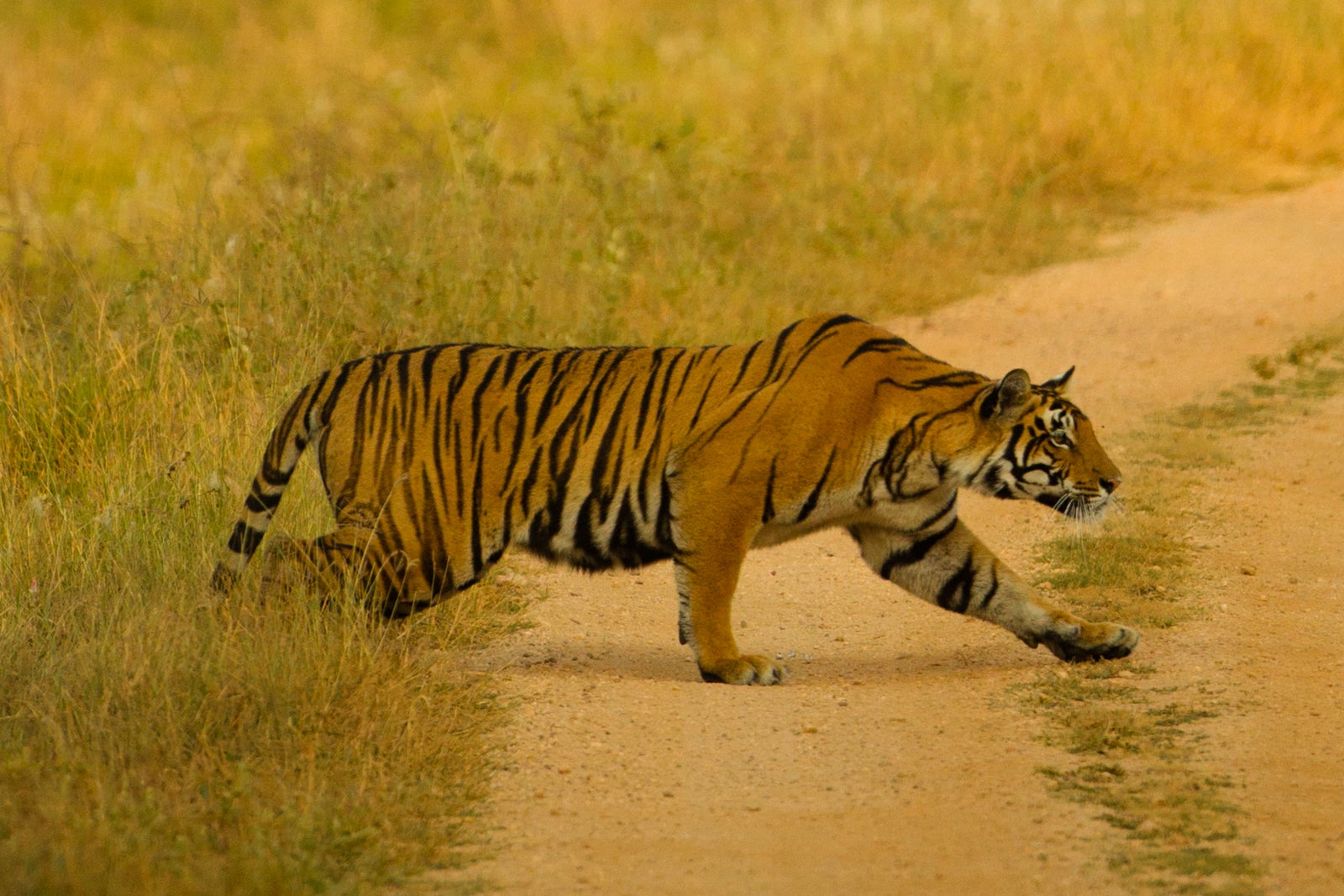
A trip to Kaziranga National Park in India isn't just about the tigers, since these lush meadows are just as well known for their population of one-horned rhinoceros, which make up close to two-thirds of the world's population. Still, there are 111 Bengal tigers here in a fairly dense area, making it a favorite for tiger-spotting. Elephants and leopards up the fun factor as well.
5. Bandipur National Park, Karnataka, India
Spanning the lush valleys of the Kabini and Moyar rivers, Bandipur National Park shelters some 109 tigers at last count. Boasting one of the highest densities of tigers per acre, Bandipur also offers wildlife photographers a wealth of other options, from Indian elephants and sloth bears to more than 200 species of birds.
6. Melghat Tiger Reserve, Maharashtra, India
Situated in the Satpura mountains near the hill town of Chikhaldara, 890-square-mile Melghat Tiger Reserve is one of India's largest tiger parks. More than 60 tigers roam the banks of the Tapti River and its tributaries. Visitors often combine a safari in Melghat with a visit to Chikhaldara and the 13th-century Mughal fortress of Gawilgarh.
7. Ranthambore National Park, Rajasthan, India
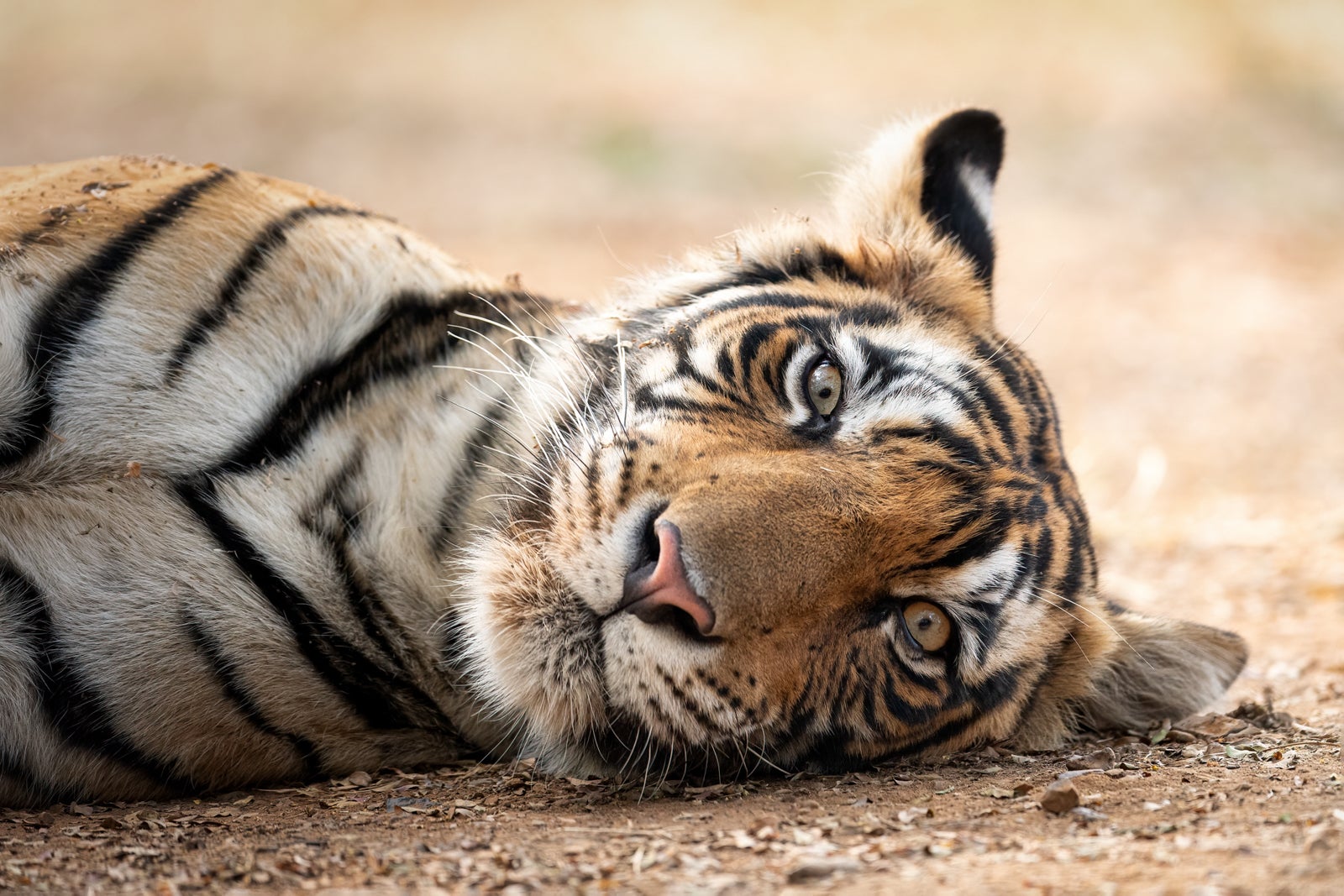
Once the royal hunting grounds of the maharajahs of Jaipur, Ranthambore National Park lures visitors with its romantic history along with its wildlife. While the park was relatively small when first established in 1955, it's been expanded over the years to 1,334 square miles, making it India's largest tiger park. Ranthambore is one of India's more popular tiger parks both due to its location in attraction-rich Rajasthan and for its high chances of tiger-spotting. Don't miss the ruins of Ranthambore Fort, built between the 10th and 16th centuries, high on a rocky butte and affording astonishing views.
8. Jim Corbett National Park, Uttarakhand, India
Called Hailey National Park when it was established in 1936 and renamed for a noted big game hunter and tiger conservationist, Jim Corbett National Park is India's oldest national park. It was here in 1973 that Corbett founded Project Tiger, now the National Tiger Conservation Authority, which played a powerful role in allowing so many of India's tigers to survive today. More than 230 tigers live in this national park which, unlike most others, has facilities for overnight stays, increasing your chances of a tiger sighting.
9. Jigme Singye Wangchuck National Park, Bhutan
When the Bhutanese government launched its first tiger count in 2015, the country's tiger population stood at 103, a number the government has proposed to double over the next decade. While Bengal tigers roam across much of the densely forested mountainous country, Jigme Singye Wangchuck National Park is one of the best places to see them, along with red pandas, golden langurs and rare clouded leopards.
10. Royal Manas National Park, Bhutan
Home to fewer than 30 critically endangered Bengal tigers, Royal Manas National Park was recognized by the World Wildlife Fund in 2020 for more than doubling its tiger population from just 12 tigers in 2008. Connected at its southern edge with India's Manas Tiger Reserve and at its northern edge with Jigme Singye Wangchuck National Park, Royal Manas greatly expands the territory over which the tigers can wander.
11. Sunderban National Park, Bangladesh
More than 200 Bengal tigers live in this swampy wetlands preserve in southwestern Bangladesh on the border with India. Canoe safaris are the transport of choice in Sunderban National Park, since its jungle-shrouded rivers are easier to navigate by boat than by vehicle, and the tigers are particularly entertaining to watch thanks to their penchant for swimming.
12. Bardia National Park, Nepal
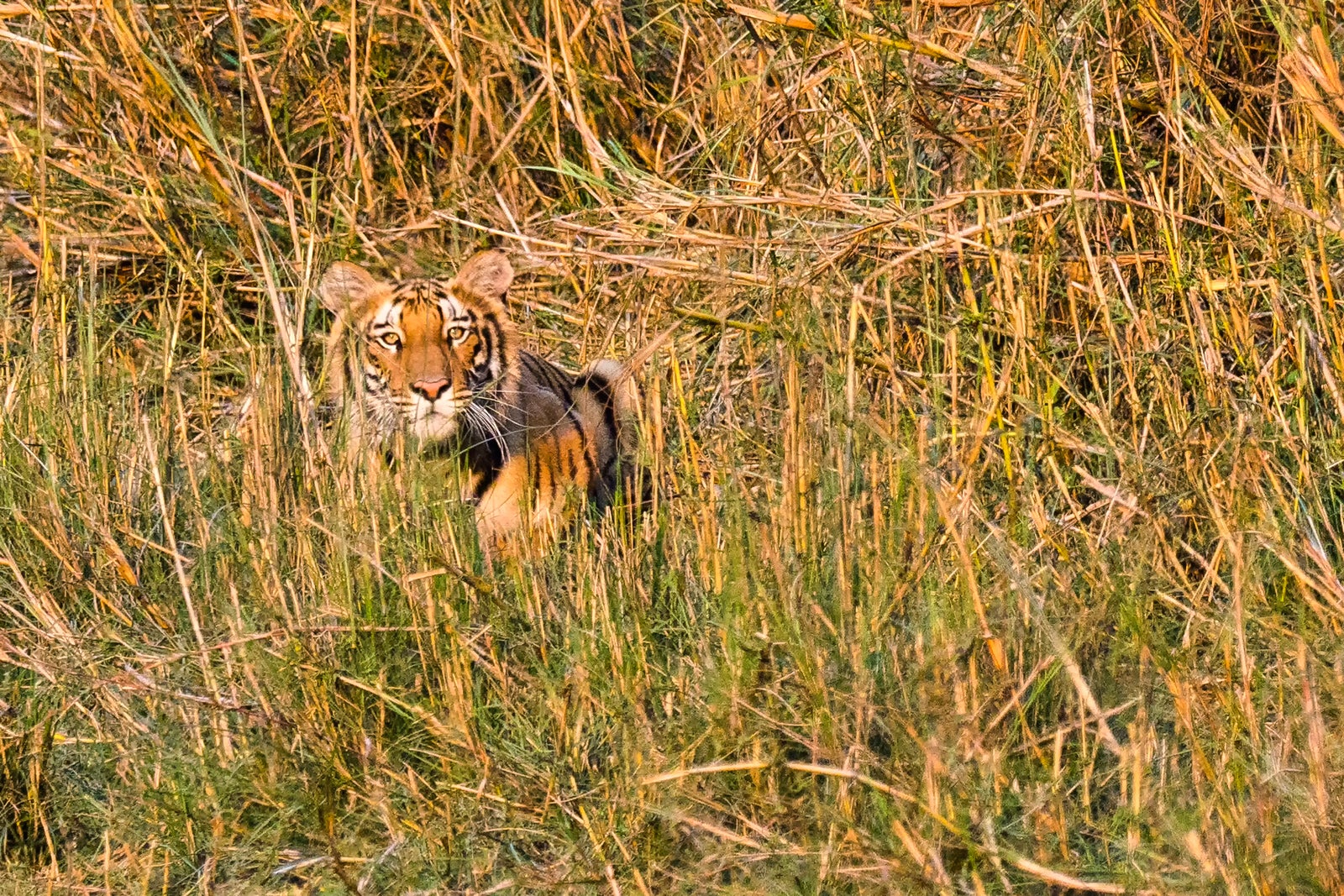
Nepal can boast one of the best tiger success stories, with the population almost doubling over the past decade. At least 235 tigers live in the country's five national parks, with Bardia National Park having the most with a population of approximately 80. In Bardia, you have a choice between a walking safari and a jeep safari. Opt for a full-day rather than half-day trip to increase your chances of seeing one of the park's resident tigers — but you'll feel just as lucky if you see one of the park's wild elephants or one-horned rhinos.
13. Chitwan National Park, Nepal
More accessible than Bardia thanks to its location near Nepal's southern border with India, Chitwan National Park has seen its conservation efforts pay off with the tiger population increasing to 235. The park's one-horned rhinoceros population is another success story, up to almost 700 from a low of 100 in the late 1960s. Even if you don't spot a tiger, a visit to Chitwan is worthwhile for a chance to watch these prehistoric-looking beasts.
14. Durminskoye Forest Reserve, Russia
This section of the taiga forest in far eastern Siberia, home to the last remaining Siberian tigers as well as rare Amur leopards, is top on the list for big cat aficionados determined to see the rarest of the rare. Remote is an understatement for this wild region, best explored as part of an organized Siberian wildlife tracking tour through a reputable outfitter such as Wild Voyager or Naturetrek .
15. Zov Tigra National Park, Russia
With a name that translates as "call of the tiger," Zov Tigra National Park defines its existence as the last refuge of the endangered Siberian or Amur tiger, the largest of all the big cats. Only 500 of these magnificent cats remain in the world, and seeing them requires joining a responsible tiger expedition best suited to the more adventurous traveler. Even so, expedition organizers warn that travelers have a 1 in 8 chance of seeing one of these elusive cats, which prefer the cover of the region's dense forests.
Advertisement
Comment and Earth
Endangered animals caught in the tourist trap.
Wildlife tourism generates conservation cash that many at-risk species now rely on to a startling degree. Curb it at their peril
By Ralf Buckley
10 October 2012

(Image: Andrzej Krauze)
INDIA is home to the largest remaining wild populations of the tiger. Even so, there are estimated to be just 1500 to 2000 Bengal tigers left. They are the poster species of the country’s tourism marketing – the face of its national pride. So no wonder a legal bid to ban visitors from the heart of conservation zones, with its potential impact on income, has reignited the debate over the connections between wildlife tourism and conservation.
The once far-flung realm of our planet’s largest cat species has been squeezed to a few poorly connected areas – mainly public, protected zones. All are under pressure. Some subspecies are already extinct in the wild, and others risk going the same way.
All are the unrelenting target of poachers controlled by gangs that supply the trade in tiger parts for traditional “medicine” in China and South-East Asia.
In India, national and state governments and local and international conservation organisations have devoted considerable effort and funds to protect these animals. As a result, the total Bengal tiger population has recovered slowly during recent decades, even allowing for inaccuracies in counts.
Increasing awareness of the animal’s plight is one component of conservation efforts, and tiger tourism is part of this. It started slowly, but has grown greatly. Tiger reserves receive tens to hundreds of thousands of visitors a year, which can cause crowds (though this pales in comparison with some wildlife parks in other countries, which get tens of millions of visitors). The animals are adversely affected by direct disturbance, new infrastructure and human in-migration.
Yet crucially, parks agencies and local communities have become dependent on tourism funding, and much of it pays for work that keeps poachers at bay – the key conservation concern for Bengal tigers. In the principal tiger state of Madhya Pradesh, which arguably leads the way in its management of nature reserves, tourism revenue is used to fund programmes for local villagers, who act as gatekeepers against poachers. These villagers also have an effect on tigers, but neither they nor the tourists are nearly as severe a threat as poaching. Revenues there also fund anti-poaching patrols, compensate villagers for livestock killed by tigers, and pay for fence construction and other programmes. One tour operator has also helped reintroduce tigers. In other states, however, parks do not receive tourism cash and suffer more severe impacts from hunters. Simply put, if tourism money is cut abruptly, poaching will increase.
Visitors who come to see tigers bring their own problems, but these can be mitigated. Even in the best of Madhya Pradesh’s reserves, such as Bandhavgarh, Pench and Kanha, there are day-to-day difficulties. The main problem is inappropriate driving by tour operators as they compete aggressively for tips from wealthy middle-class domestic tourists. This leads to breaches of minimal-impact wildlife-watching protocols, which aim to restrict vehicle speeds, animal-approach distances and crowding.
Fitting vehicles with GPS units and cameras could help enforcement of the rules. Yet even if tigers are disturbed, at least it is only along roads and by day. Recent research shows they avoid humans by hunting at night.
Ultimately, conservationists want tourism to fund expansions of India’s protected areas, by buying, rehabilitating and restocking land to create private conservation reserves, as in Africa. For this, tour operators first need cash flow; for that, they need access to areas where tigers are relaxed around humans, so that they can be seen by tourists. And that only happens in areas without poachers or villages, in the core sections of national parks that are the focus of legal action.
India is a great example of the growing reliance of conservation on tourism, but it is widespread. Over 1000 mammal species are on the Red List of the International Union for Conservation of Nature as critically endangered, endangered or vulnerable. A recent analysis I and my colleagues have done shows that conservation of many such species has become reliant on revenue from tourism to a previously unsuspected degree ( PLoS One , doi.org/jgj ). On one hand, this brings new opportunities for conservation funding, but on the other, dependence on such an uncertain income creates a new vulnerability, were it to suddenly dry up.
“The increasing reliance of conservation on tourism is widespread. Take tourism away and animals die”
In Madagascar, Nepal and Zimbabwe, where tourism collapsed following unrest, many threatened species suffered greatly increased poaching. So sudden changes are best avoided.
It is not just poachers that are a problem: bushmeat hunters, logging and mining, invasive weeds, feral animals, hydro dams and power lines are all threats. And while parks services in wealthy nations have billion-dollar annual budgets to resist these threats, in some developing countries they have to manage on less than $10,000.
For over half of the red-listed mammal species with available data, at least 5 per cent of all wild individuals rely on tourism revenue to survive. For one in five species – including rhinos, lions and elephants – that rises to at least 15 per cent of individuals. Yes, that’s risky, because tourism is fickle: but take it away and animals are killed by hunters. It happens every single day, every time patrols stop or hungry locals lose conservation incentives.
In India, some conservationists think tigers would be better off without tourists. They brought a case for a ban to the Supreme Court as a doomsday weapon, to force a response. But in Madhya Pradesh at least, the parks agency, tour operators and wildlife groups all believe a ban would cause more harm than good. A negotiated approach that allows tourism to continue is eminently sensible.
- conservation /
- endangered species
Sign up to our weekly newsletter
Receive a weekly dose of discovery in your inbox! We'll also keep you up to date with New Scientist events and special offers.
More from New Scientist
Explore the latest news, articles and features

China is sending giant pandas to US zoos for the first time in decades
Subscriber-only

Endangered giant pangolin spotted in Senegal after nearly 24 years

Snares are wiping out South-East Asian wildlife – what can be done?

Asian hornets have overwintered in the UK for the first time
Popular articles.
Trending New Scientist articles
Tiger Tourism: Balancing Ecotourism and Wildlife Protection
1. the rise of tiger tourism, 2. the importance of tiger conservation, 3. ecotourism and its impact on tiger populations, 4. challenges and solutions, 5. best practices for tour operators and travelers, 6. community involvement in tiger conservation, 7. the role of governments in tiger conservation and ecotourism, 8. successful tiger conservation and tourism projects, 9. a sustainable future for tiger tourism.
In recent years, the popularity of tiger tourism has increased significantly, leading to a rise in the number of visitors to national parks and wildlife reserves where tigers can be spotted. While this has helped raise awareness about the importance of tiger conservation, it has also raised concerns about the impact of tourism on the environment and the wildlife. Some argue that tiger tourism is essential to the survival of the species, as it generates revenue that can be used to fund conservation efforts. Others, however, argue that it can have a negative impact on the tigers, their habitat, and the local communities.
To better understand this complex issue, here are some in-depth insights:
1. The positive impact of tiger tourism:
Many conservationists argue that tiger tourism can have a positive impact on the species and their habitat. By generating revenue, tiger tourism can fund conservation efforts, such as anti-poaching measures, habitat restoration, and community-based conservation programs. This, in turn, can help protect the tigers and their ecosystem, as well as support the livelihoods of local communities.
For example, in India's Bandhavgarh National Park, tiger tourism has helped increase the tiger population from 46 in 2006 to 105 in 2019. The revenue generated from tourism has been used to fund anti-poaching patrols, habitat restoration, and community-based conservation programs, which have helped reduce the threats to the tigers and their habitat.
2. The negative impact of tiger tourism:
On the other hand, some argue that tiger tourism can have a negative impact on the environment and the wildlife. The increasing number of visitors can lead to habitat degradation, disturbance to the animals, and increased pollution. Furthermore, some tourists may not follow the rules and regulations , which can lead to further damage to the ecosystem.
For instance, in Thailand's Tiger Temple, tigers were allegedly subjected to cruel treatment and were kept in poor conditions. The temple was eventually closed down, and the tigers were rescued and relocated to a wildlife sanctuary.
3. Balancing ecotourism and wildlife protection:
To address these concerns, it is essential to find a balance between ecotourism and wildlife protection. This can be achieved by implementing strict regulations and guidelines for tourism activities, such as limiting the number of visitors, enforcing strict codes of conduct, and promoting responsible tourism practices. Additionally, involving local communities in conservation efforts and providing them with alternative livelihoods can help reduce the pressure on the ecosystem and support the conservation of tigers and their habitat.
Tiger tourism is a complex issue that requires careful consideration of its impact on the environment, the wildlife, and the local communities. While it can have positive benefits for conservation efforts, it is important to ensure that it is done in a responsible and sustainable manner.
The Rise of Tiger Tourism - Tiger Tourism: Balancing Ecotourism and Wildlife Protection
The tiger, an apex predator, is a vital component of the ecological balance of the habitat it inhabits. Tigers play a crucial role in maintaining the food chain, and their conservation is essential to protect the biodiversity of the ecosystem. However, the global population of tigers has decreased drastically over the years due to habitat loss, poaching, and human-wildlife conflict . Therefore, the importance of tiger conservation cannot be overstated.
Here are some key points that highlight why tiger conservation is crucial:
1. Ecological balance: Tigers are at the top of the food chain, and their presence in the ecosystem ensures that the population of herbivores like deer and wild boars is kept in check, thereby maintaining the ecological balance of the habitat.
2. Biodiversity: Tigers are an umbrella species, which means their protection helps preserve the entire ecosystem of the habitat. Conserving tigers ensures the survival of other species that share the same habitat.
3. Cultural significance: Tigers are not only ecologically important but also culturally significant. In many countries, tigers are revered as deities and are an integral part of the local culture and tradition.
4. Economic benefits: Tiger conservation can provide significant economic benefits to local communities . Ecotourism, when done responsibly, can generate income and employment opportunities for local communities while conserving tigers and their habitat.
5. Global impact: The conservation of tigers has a global impact as it helps mitigate climate change. Tiger habitats, such as forests and grasslands, store carbon and play a vital role in regulating the earth's climate.
The importance of tiger conservation cannot be overstated. Protecting tigers and their habitat not only benefits the ecosystem and biodiversity but also has significant economic and cultural significance. It is crucial to balance ecotourism and wildlife protection to conserve tigers while ensuring the well-being of local communities and their livelihoods.
The Importance of Tiger Conservation - Tiger Tourism: Balancing Ecotourism and Wildlife Protection
The practice of ecotourism has become increasingly popular in recent years, with tourists flocking to natural habitats to experience the beauty of nature and wildlife. However, with an increase in ecotourism comes an increase in foot traffic , which can have a significant impact on the environment and the animals that inhabit it. The issue becomes even more complicated when it comes to ecotourism and tiger populations. While ecotourism can provide much-needed revenue for conservation efforts and support local communities , it can also disrupt the delicate balance of tiger habitats and lead to negative consequences for these majestic animals.
Here are some insights on the impact of ecotourism on tiger populations:
1. Ecotourism can lead to habitat destruction: The construction of hotels, roads, and other infrastructure to support ecotourism can lead to the destruction of natural habitats, which can have a negative impact on tiger populations. Tigers require large areas of undisturbed forest to thrive, and the destruction of their habitat can lead to a decline in their numbers.
2. Ecotourism can disrupt tiger behavior: The presence of tourists can disrupt the natural behavior of tigers, which can impact their mating and hunting patterns. For example, tigers may become habituated to humans and lose their fear of them, which can lead to dangerous encounters in the future.
3. Ecotourism can lead to poaching: While ecotourism can provide much-needed revenue for conservation efforts, it can also attract poachers who are looking to profit from the sale of tiger parts on the black market. This can have a devastating impact on tiger populations, which are already under threat from habitat loss and other factors.
4. Ecotourism can support conservation efforts: Despite the potential negative impacts of ecotourism, it can also be a powerful tool for conservation. Revenue generated from ecotourism can be used to support conservation efforts and provide economic opportunities for local communities. For example, in India, ecotourism has helped to increase tiger populations by providing financial incentives for conservation efforts.
5. Ecotourism needs to be properly managed: To minimize the negative impacts of ecotourism on tiger populations, it is essential that it is properly managed. This can include limiting the number of tourists allowed in a particular area, ensuring that infrastructure is built in a sustainable manner, and enforcing strict regulations to prevent poaching and other illegal activities.
While ecotourism can have both positive and negative impacts on tiger populations, it is clear that it can be an effective tool for conservation when properly managed. By balancing the needs of tourists, local communities, and wildlife, we can ensure that ecotourism has a positive impact on tiger populations and the environment as a whole.
Ecotourism and Its Impact on Tiger Populations - Tiger Tourism: Balancing Ecotourism and Wildlife Protection
Ecotourism has become a popular way to explore new places while also being mindful of the environment and wildlife. While it can bring in money and raise awareness for conservation efforts, it can also have negative impacts on the very wildlife it aims to protect. As with any topic, there are differing opinions and perspectives on how to balance ecotourism and wildlife protection. Some argue that ecotourism can help fund conservation efforts, while others argue that it can lead to exploitation of wildlife and their habitats. However, with proper planning and management, it is possible to create a system where ecotourism and wildlife protection can coexist.
Here are some challenges and solutions to consider when balancing ecotourism and wildlife protection:
1. Overcrowding: One of the most significant challenges of ecotourism is overcrowding, which can disturb and even harm the wildlife. To address this issue, park managers can implement measures such as limiting the number of visitors per day, setting up designated viewing areas, and creating off-limits areas for animals.
2. Encouraging Responsible Tourism: Encouraging responsible tourism is essential to minimize the negative impacts of ecotourism. This can be done by educating visitors on how to behave around wildlife, promoting ethical practices such as not littering and not feeding the animals, and offering alternative activities to reduce pressure on the wildlife, such as hiking and bird watching.
3. Community Involvement: Involving local communities in ecotourism can ensure that the benefits are shared while also supporting conservation efforts. For example, ecotourism can provide job opportunities for locals, and the revenue generated can be used to fund conservation efforts or support community development projects.
4. Balancing Conservation and Economic Interests: One of the biggest challenges in balancing ecotourism and wildlife protection is finding a balance between conservation and economic interests. While it is important to generate revenue from ecotourism to support conservation efforts, it is equally important to ensure that the wildlife is not exploited for economic gain. One solution is to establish clear guidelines and regulations on ecotourism activities, such as limiting the number of safaris per day and mandating the use of licensed guides.
5. Monitoring and Evaluation: The success of ecotourism in balancing conservation and economic interests depends on effective monitoring and evaluation. This can be done by setting up monitoring systems to track visitor numbers, wildlife behavior, and ecological impacts. This information can then be used to make informed decisions on how to manage ecotourism activities and ensure the protection of the wildlife.
Ecotourism has the potential to benefit both wildlife and local communities, but it must be managed carefully to ensure that it does not harm the very things it aims to protect. By addressing the challenges and implementing solutions such as responsible tourism, community involvement, and effective monitoring and evaluation, it is possible to create a system where ecotourism and wildlife protection can coexist.
Challenges and Solutions - Tiger Tourism: Balancing Ecotourism and Wildlife Protection
One of the most important aspects of responsible tiger tourism is ensuring that tour operators and travelers are following best practices that prioritize the well-being and protection of tigers and their natural habitat . This can be achieved through a combination of education, regulation, and responsible behavior on the part of all stakeholders involved. From the perspective of tour operators, it is crucial to work with local communities and conservation organizations to develop sustainable tourism practices that not only support the local economy but also help to protect the environment and wildlife. This can include things like limiting the number of visitors to sensitive areas, providing educational materials to visitors, and investing in conservation efforts.
On the other hand, travelers also have a responsibility to ensure that their actions are not harming the very wildlife they have come to see. This means avoiding behaviors that can be harmful, such as getting too close to tigers or disturbing their natural habitat. Additionally, travelers should make an effort to choose tour operators that prioritize responsible and sustainable tourism practices. By doing so, they can help to support conservation efforts and ensure that future generations will be able to enjoy the beauty of tigers and their natural habitat.
To further emphasize the importance of responsible tiger tourism, here are some best practices that can be adopted by both tour operators and travelers:
1. Limit the number of visitors: Overcrowding can be harmful to tigers and their habitat, so it is important to limit the number of visitors to sensitive areas. This can help to reduce the impact of tourism on the environment while also ensuring that visitors have a more enjoyable experience.
2. Provide educational materials: Providing educational materials to visitors can help to increase awareness about the importance of conservation and responsible tourism practices. This can include things like brochures, signage, and guided tours that focus on the natural history and conservation of tigers.
3. Invest in conservation efforts: Tour operators can make a significant impact by investing in conservation efforts that help to protect tigers and their habitat. This can include things like supporting local conservation organizations, contributing to research efforts, and implementing sustainable tourism practices.
4. Choose responsible tour operators: Travelers can make a difference by choosing tour operators that prioritize responsible and sustainable tourism practices. This can include researching tour operators before booking a trip, asking questions about their practices, and supporting operators that have a proven track record of supporting conservation efforts.
By adopting these best practices, tour operators and travelers can work together to ensure that tiger tourism is both sustainable and responsible. This can help to protect tigers and their natural habitat while also providing visitors with a once-in-a-lifetime experience.
Best Practices for Tour Operators and Travelers - Tiger Tourism: Balancing Ecotourism and Wildlife Protection
As humans, it is our responsibility to protect and conserve the wildlife around us. Tigers, for example, are one of the most majestic and beautiful creatures that roam our planet. However, their existence is threatened due to habitat loss, poaching, and other human activities. To ensure the survival of tigers, it is essential that we involve the local communities in the conservation efforts.
1. Education and Awareness: Educating the local communities about the importance of tiger conservation can go a long way in protecting these big cats. By raising awareness, we can encourage the locals to report any poaching or wildlife crimes they witness. Moreover, education can also help to reduce human-tiger conflicts. For instance, the Sundarbans, home to the largest population of tigers, has seen a significant decrease in tiger attacks on humans due to awareness campaigns.
2. Alternative Livelihoods: Many communities depend on forest resources for their livelihoods, which can often lead to conflict with the tigers. Providing alternative livelihoods such as ecotourism, handicrafts, and sustainable agriculture can help to reduce this conflict. For example, the village of Tadoba in India has seen a significant reduction in tiger poaching after the introduction of ecotourism.
3. Community-Based Conservation Programs: Involving the local communities in conservation programs can help to create a sense of ownership and responsibility towards protecting the wildlife. For instance, the Satpura Tiger Reserve in India has implemented a community-based conservation program where the locals are trained as guides, drivers, and trackers for the tourists. This has not only provided employment opportunities but also helped to reduce poaching and other wildlife crimes.
4. Government Support: The government plays a crucial role in tiger conservation, and it is essential that they involve the local communities in the decision-making process . Providing the communities with a voice in conservation planning can help to address their concerns and ensure that the conservation efforts are sustainable in the long run .
Involving the local communities in tiger conservation is crucial for the survival of these magnificent creatures. By providing education, alternative livelihoods, community-based conservation programs, and government support, we can ensure that tigers continue to thrive in their natural habitat.
Community Involvement in Tiger Conservation - Tiger Tourism: Balancing Ecotourism and Wildlife Protection
The role of governments in tiger conservation and ecotourism is crucial to ensure the protection of tigers in the wild while also promoting sustainable tourism. Governments play a pivotal role in creating and implementing policies that regulate the tourism industry and protect wildlife habitats. However, this role is often complicated by the competing interests of conservation and economic development. Some argue that ecotourism can provide a significant source of income for local communities and incentivize them to preserve wildlife habitats, while others argue that it can also lead to the exploitation of natural resources and wildlife.
To address these issues, governments have implemented various strategies to balance ecotourism and wildlife protection. Here are some examples:
1. Establishing protected areas: Governments can create protected areas such as national parks and wildlife reserves to conserve tiger habitats and restrict human activities in these areas. For example, India's Project Tiger has created 50 tiger reserves across the country, covering an area of 72,749 square kilometers.
2. Developing ecotourism guidelines: Governments can develop ecotourism guidelines that promote sustainable tourism practices and minimize the negative impact of tourism on wildlife habitats. For example, in Nepal, the Sustainable Tourism Network has developed guidelines for trekking and ecotourism that emphasize responsible tourism practices.
3. Providing incentives for local communities: Governments can provide financial incentives for local communities to engage in conservation efforts and promote ecotourism. For example, in Malaysia, the government has established a community-based ecotourism program in the Belum-Temengor Forest Complex that provides income opportunities for local communities and supports conservation efforts.
4. Strengthening law enforcement: Governments can strengthen law enforcement efforts to combat poaching and illegal wildlife trade . For example, in Thailand, the government has established the National Ivory and Tiger Task Force to combat wildlife trafficking and has increased penalties for poaching and illegal wildlife trade.
In summary, the role of governments in tiger conservation and ecotourism is crucial to ensure the protection of tigers in the wild while also promoting sustainable tourism. Governments can play an active role by establishing protected areas, developing ecotourism guidelines, providing incentives for local communities, and strengthening law enforcement efforts. By balancing ecotourism and wildlife protection, governments can create a sustainable future for both tigers and local communities.
The Role of Governments in Tiger Conservation and Ecotourism - Tiger Tourism: Balancing Ecotourism and Wildlife Protection
Tiger conservation and tourism projects can be a tricky balancing act. On one hand, tourism can provide much-needed funding for conservation efforts, and it can also raise awareness about the importance of protecting these majestic animals. On the other hand, too much tourism can be damaging to the environment and disrupt the natural behavior of the tigers. However, there are successful tiger conservation and tourism projects that have found a way to strike a balance between these two goals.
Here are some examples of successful tiger conservation and tourism projects:
1. Kanha National Park in India: This park has successfully implemented a program called "Village Eco Development" that involves local communities in conservation efforts. This has helped to reduce human-tiger conflicts and has also created economic opportunities for the local people. The park has also implemented strict regulations on the number of tourists allowed in the park at any given time.
2. Pench Tiger Reserve in India: This reserve has implemented a program called "Collarwali" that involves tracking and monitoring the behavior of tigers in the reserve. This has helped to reduce human-tiger conflicts by providing early warning systems to nearby villages. The reserve has also implemented a program called "Tribal Entrepreneurship Development" that provides economic opportunities to local communities through ecotourism.
3. Chitwan National Park in Nepal: This park has successfully implemented a program called "Community Based Anti-Poaching Units" that involves local communities in anti-poaching efforts. This has helped to reduce poaching in the park and has also created economic opportunities for the local people through ecotourism.
Overall, successful tiger conservation and tourism projects involve a combination of factors, including community involvement, strict regulations on tourism, and innovative conservation strategies. By finding a way to balance the needs of the tigers with the needs of the local communities and tourists, these projects are helping to ensure the survival of these magnificent animals for generations to come.
Successful Tiger Conservation and Tourism Projects - Tiger Tourism: Balancing Ecotourism and Wildlife Protection
As the discussion on tiger tourism continues, it is important to consider the sustainability of this industry. While it can provide economic benefits and raise awareness for conservation efforts, it can also have negative impacts on the ecosystem and the animals themselves. It is necessary to balance the need for tourism with the protection of wildlife.
Here are some key considerations for achieving a sustainable future for tiger tourism:
1. Implementing responsible tourism practices: Tour operators should follow ethical guidelines that prioritize the welfare of the animals and minimize disturbances to their natural habitats. This includes limiting the number of visitors, avoiding off-road driving, and educating tourists on how to behave around wildlife.
2. supporting local communities : Tiger tourism can provide economic opportunities for local communities, but it is important to ensure that they are not negatively impacted by tourism. supporting local businesses and providing training and employment opportunities can help to ensure that the benefits of tourism are shared fairly.
3. Investing in conservation efforts: The revenue generated by tiger tourism can be used to fund conservation efforts, such as anti-poaching initiatives and habitat restoration projects. This can help to ensure the long-term survival of tigers and their ecosystems.
4. Prioritizing research and monitoring: It is important to continue researching the impacts of tiger tourism on wildlife and ecosystems, and to monitor the effectiveness of conservation efforts. This can help to identify areas for improvement and ensure that tourism is having a positive impact.
Tiger tourism can be a valuable tool for conservation and economic development, but it must be managed responsibly and sustainably. By prioritizing the welfare of wildlife, supporting local communities, investing in conservation efforts, and continuing to research and monitor the impacts of tourism, we can ensure a brighter future for tigers and their ecosystems.
A Sustainable Future for Tiger Tourism - Tiger Tourism: Balancing Ecotourism and Wildlife Protection
Read Other Blogs
1. Understanding Libor Rates and Their Significance in Forward Swap Pricing Libor rates play a...
Understanding the Role of Authorized Participants in ETFs In the world of exchange-traded funds...
1. Defining Data Integrity: At its core, data integrity refers to the...
In the realm of social entrepreneurship, mental health social enterprises (MHSEs) emerge as a...
The surge in educational technology investments has become a pivotal aspect of the modern...
In recent years, a transformative shift has been observed in the way students are transported to...
Cause marketing is a type of marketing strategy that involves a collaboration between a for-profit...
Systematic risk, also known as market risk, is the risk that affects the entire market or a large...
In an era where digital platforms dominate the marketing landscape, the potency of face-to-face...
Thank you for visiting nature.com. You are using a browser version with limited support for CSS. To obtain the best experience, we recommend you use a more up to date browser (or turn off compatibility mode in Internet Explorer). In the meantime, to ensure continued support, we are displaying the site without styles and JavaScript.
- View all journals
- Explore content
- About the journal
- Sign up for alerts
- NEWS FEATURE
- 16 September 2022
Tigers are a natural attraction for tourists
- Arathi Menon
You can also search for this author in PubMed Google Scholar
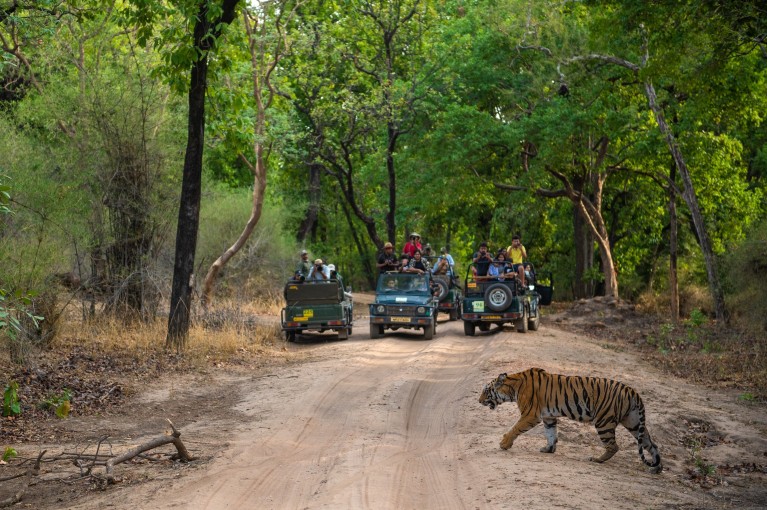
Credit: Aravind Ramamurthy
A new study by the Centre for Wildlife Studies supports the idea that for tourists in India’s nature reserves, tigers are the biggest drawcard.
“Since nature tourism is gaining popularity, we conducted a survey to understand tourists’ preferences – this could help managers of protected areas to strategize and generate revenue better,” according to the lead author of the study Dincy Mariyam.
To determine what attracted people, Mariyam and her team conducted the study at three tiger reserves—Bandipur, Kanha and Sundarbans. Though the researchers say that these protected areas were chosen for their high tourist numbers, one limitation of the study is that all three locations are designated tiger reserves, where tourists come with the primary intention of sighting a tiger.
The team found that the charismatic big cat was the most popular reason for them to visit, followed by beauty of reserve landscapes. Mariyam says that factors, including prior engagement in conservation issues, age, and gender could also have an effect on reasons for interest in low-profile categories such as herpetofauna and flora. For example, female tourists showed more interest in plants and trees, and younger tourists, especially those with experience in conservation activities, were more likely to value lesser-known fauna.
“The tiger is the most charismatic carnivore and has attributes like courage, stealth and confidence which a lot of people want to see in themselves. Spotting one in the wild is thrilling,” says Anish Andheria, president and CEO of the Wildlife Conservation Trust.
The authors considered the question of whether tourists who do not see a tiger would be deterred from future visits to a reserve. Andheria says nature observers are more informed and are interested in other species, not always tigers. “In Kanha, for example, tourists show a lot of interest in the endangered Barasingha (swamp deer),” he says.
India is a megadiverse country and has seen a 171% growth in PA visitation between 2005 and 2015, with 4.6 million visits, the study says. Previous studies have shown that nature-based tourism in India is largely domestic, with Indian tourists accounting for 96% of all visitors.
David Raju, a nature guide who has worked in many major PAs, like Kanha, Pench, Satpura and Tadoba national parks, says that he has observed varied interests in tourists. “These studies need to be done in PAs other than tiger reserves as well for accuracy,” he says. In his current role at Wayanad, Raju says two popular guides who focus on frogs and reptiles are booked for months in advance by tourists and photographers. “What we see in most tiger reserves is that the guides do not make an effort to take the experience beyond tiger sightings. It is an easy route with high satisfaction levels in places like Kanha and Pench where the tigers are habituated to vehicles and come closer.”
Tiger reserves have played a major role in protecting forest biodiversity. Andheria, a steering committee member of the National Tiger Conservation Authority (NTCA), says that after the launch of Project Tiger in 1973, the country rode on tigers’ popularity to create 53 tiger reserves with all types of landscapes and biodiversity. “If you want to protect frog species, no authority will show interest. But tiger holds sway, and when you create a tiger reserve, the frog is also protected.”
Andheria says the best habitat for elephants in the country is the tiger reserves. “Many rivers originate from or are fed by tiger reserves thus maintaining the hydrology of the region. So Project Tiger was an initiative that seemed to focus on tigers, but took conservation beyond them,” he says.
Mariyam says that the study also sought to discover whether there was an interest in lesser-known species like herpetofauna. “Most tourists are not willing to brave hostile conditions like leeches and ticks to get to their habitats. Tigers are easily spotted in spaces they are habituated to and everyone, from the young to the old, or unfit, can sit on a jeep and go to its habitat to spot one,” Anish says.
Raju says that a trained guide can generate and sustain visitor interest in a well-rounded PA experience. He says organizations such as Taj Safari, Pugdundee, and NGOs, including Nature Conservation Foundation (NCF) are now invested in training guides. “The NTCA is already working on creating quality interpretation centres in every tiger reserve in the country,” says Andheria.
doi: https://doi.org/10.1038/d44151-022-00096-4
Reprints and permissions
Senior Project Manager
The Senior Project Manager will play a key role in enabling Springer Nature’s OA transformation, and optimising and expanding our OA business.
London – Hybrid Working Model
Springer Nature Ltd
Senior Commercial Manager (Open Access)
This position offers a unique opportunity to influence the future of open access publishing.
Postdoctoral Fellow in Immunology at Northwestern University
Our T cell biology lab is looking for fellows interested in improving immunotherapies for cancer and autoimmune disease through immune engineering.
Chicago, Illinois
Choi Laboratory at Northwestern
Faculty Positions in School of Engineering, Westlake University
The School of Engineering (SOE) at Westlake University is seeking to fill multiple tenured or tenure-track faculty positions in all ranks.
Hangzhou, Zhejiang, China
Westlake University
High-Level Talents at the First Affiliated Hospital of Nanchang University
For clinical medicine and basic medicine; basic research of emerging inter-disciplines and medical big data.
Nanchang, Jiangxi, China
The First Affiliated Hospital of Nanchang University
Sign up for the Nature Briefing newsletter — what matters in science, free to your inbox daily.
Quick links
- Explore articles by subject
- Guide to authors
- Editorial policies
- Newsletters
- Account Activating this button will toggle the display of additional content Account Sign out
Tigers Need Tourist Traps
The best protection many endangered species have is tourism dollars..
A tiger is seen during a jungle safari at the Ranthambore National Park in Ranthambore, India, around 200kms from Jaipur.
Photo by Manan Vatsyayana/AFP/Getty Images.
India is home to the largest remaining wild populations of the tiger. Even so, there are estimated to be just 1,500 to 2,000 Bengal tigers left. They are the poster species of the country’s tourism marketing—the face of its national pride. So no wonder a legal bid to ban visitors from the heart of conservation zones , with its potential impact on income, has reignited the debate over the connections between wildlife tourism and conservation.
The once far-flung realm of our planet’s largest cat species has been squeezed to a few poorly connected areas—mainly public, protected zones. All are under pressure. Some subspecies are already extinct in the wild, and others risk going the same way.
All are the unrelenting target of poachers controlled by gangs that supply the trade in tiger parts for traditional “medicine” in China and Southeast Asia.
In India, national and state governments and local and international conservation organizations have devoted considerable effort and funds to protect these animals. As a result, the total Bengal tiger population has recovered slowly during recent decades, even allowing for inaccuracies in counts.
Increasing awareness of the animal’s plight is one component of conservation efforts, and tiger tourism is part of this. It started slowly but has grown greatly. Tiger reserves receive tens to hundreds of thousands of visitors a year, which can cause crowds (though this pales in comparison with some wildlife parks in other countries, which get tens of millions of visitors). The animals are adversely affected by direct disturbance, new infrastructure, and human in-migration.
Yet crucially, parks agencies and local communities have become dependent on tourism funding, and much of it pays for work that keeps poachers at bay—the key conservation concern for Bengal tigers. In the principal tiger state of Madhya Pradesh, which arguably leads the way in its management of nature reserves, tourism revenue is used to fund programs for local villagers, who act as gatekeepers against poachers. These villagers also have an effect on tigers, but neither they nor the tourists are nearly as severe a threat as poaching. Revenues there also fund anti-poaching patrols, compensate villagers for livestock killed by tigers, and pay for fence construction and other programs. One tour operator has also helped reintroduce tigers. In other states, however, parks do not receive tourism cash and suffer more severe impacts from hunters. Simply put, if tourism money is cut abruptly, poaching will increase.
Visitors who come to see tigers bring their own problems, but these can be mitigated. Even in the best of Madhya Pradesh’s reserves, such as Bandhavgarh, Pench, and Kanha, there are day-to-day difficulties. The main problem is inappropriate driving by tour operators as they compete aggressively for tips from tourists. This leads to breaches of minimal-impact wildlife-watching protocols, which aim to restrict vehicle speeds, animal-approach distances, and crowding.
Fitting vehicles with GPS units and cameras could help enforcement of the rules. Yet even if tigers are disturbed, at least it is only along roads and by day. Recent research shows they avoid humans by hunting at night.
Ultimately, conservationists want tourism to fund expansions of India’s protected areas, by buying, rehabilitating, and restocking land to create private conservation reserves, as in Africa. For this, tour operators first need cash flow; for that, they need access to areas where tigers are relaxed around humans, so that they can be seen by tourists. And that only happens in areas without poachers or villages, in the core sections of national parks that are the focus of legal action.
India is a great example of the growing reliance of conservation on tourism, but it is widespread. Over 1,000 mammal species are on the Red List of the International Union for Conservation of Nature as critically endangered, endangered, or vulnerable. A recent analysis I and my colleagues have done shows that conservation of many such species has become reliant on revenue from tourism to a previously unsuspected degree. On one hand, this brings new opportunities for conservation funding, but on the other, dependence on such an uncertain income creates a new vulnerability, were it to suddenly dry up.
In Madagascar, Nepal, and Zimbabwe, where tourism collapsed following unrest, many threatened species suffered greatly increased poaching. So sudden changes are best avoided.
It is not just poachers that are a problem: Bushmeat hunters, logging and mining, invasive weeds, feral animals, hydro dams, and power lines are all threats. And while parks services in wealthy nations have billion-dollar annual budgets to resist these threats, in some developing countries they have to manage on less than $10,000.
For over half of the red-listed mammal species with available data, at least 5 percent of all wild individuals rely on tourism revenue to survive. For one in five species—including rhinos, lions, and elephants—that rises to at least 15 percent of individuals. Yes, that’s risky, because tourism is fickle—but take it away and animals are killed by hunters. It happens every single day, every time patrols stop or hungry locals lose conservation incentives.
In India, some conservationists think tigers would be better off without tourists. They brought a case for a ban to the Supreme Court as a doomsday weapon, to force a response. But in Madhya Pradesh at least, the parks agency, tour operators and wildlife groups all believe a ban would cause more harm than good. A negotiated approach that allows tourism to continue is eminently sensible.
This article originally appeared in New Scientist .
Update: India just lifted its ban on tiger tourism and is establishing new guidelines for tourism and conservation.

A new study says that elephant rides, such as this one in Sri Lanka, and other wildlife tourist attractions, are not good for animals’ welfare.
- WILDLIFE WATCH
Visitors Can’t Tell If a Tourist Attraction Is Bad for Animals
A new study ranks wildlife tourist attractions around the world based on how they treat their animals and whether they help save species.
In the first major study of wildlife tourism around the world, researchers at the University of Oxford’s Wildlife Conservation Research Unit—the same group that had been studying Cecil the Lion before he was shot in July—found that the millions of people who visit wildlife attractions each year don’t seem to realize that places they’re visiting have ill effects on animals.
Wildlife attractions account for between 20 and 40 percent of all tourism worldwide, with 3.6 to six million people visiting these sites annually. The study found that every year two to four million tourists financially support attractions that aren’t good for animal welfare or conservation. And it found that 80 percent of reviewers didn’t recognize that certain wildlife attractions weren’t good for the animals.
Led by conservation biologist Tom Moorhouse, the researchers compared 24 types of wildlife tourist attractions to thousands of evaluations on TripAdvisor, a travel review and ratings website.
They grouped wildlife tourist attractions into five categories: interactions with captive animals (such as elephant treks and encounters with big cats); sanctuaries, whose main purpose is to help and protect wild animals; wildlife farms where tourists observe animals bred for other purposes, such as crocodiles for meat and leather and bears whose gallbladders are “milked” for bile for traditional medicines); street performances; and wild attractions such as gorilla trekking and polar bear sightseeing.
The researchers rated each type of attraction on animal welfare and conservation. Animal welfare scores were based on factors such as adequate food and water, freedom from pain and injury, ability to behave normally, and level of stress.

Wildlife sanctuaries are among the few wildlife tourist attractions that receive good marks on animal welfare. At the Buddhist Tiger Temple in Thailand, however, advocates have raised questions about the cats’ well-being, and it is under investigation by local authorities.
Conservation scores were based on, for instance, where the animals came from and whether proceeds help preserve the species through habitat protection, anti-poaching efforts, and so on.
Not surprisingly, animal sanctuaries received positive scores for both animal welfare and conservation. Street performances—dancing macaques and snake charming, for example—received negative scores on both.
Swim-with-the-dolphin interactions, elephant rides, shark cage diving, and crocodile, sea turtle, and bear bile farms get the highest number of visitors each year (more than 500,000 visitors), and they all have negative impacts on animal welfare.
Our rule of thumb: avoid any wildlife attraction that scores under 80 percent on TripAdvisor. David Macdonald , Director of Oxford’s Wildlife Conservation Research Unit
On the other hand, bear sanctuaries also receive a high number of tourists each year, and they rate well both in terms of welfare and conservation.
“Some of the most concerning types of wildlife attractions...received overwhelmingly positive reviews from tourists,” said Neil D’Cruze, one of the study’s authors and the head of research at World Animal Protection, an animal welfare nonprofit based in London, in a press release.
For example, only 18 percent of reviews for tiger attractions, which received the lowest possible animal welfare rating, mentioned concerns about the welfare of the animals.The other 82 percent of reviewers rated the tiger attractions as “excellent” or “very good.”
“How sad it is that tourists, often no doubt lured in as a result of a well-intentioned interest in animals, thereby support attractions that not only keep wild animals in bad conditions but damage their conservation,” said David Macdonald, the director of Oxford’s Wildlife Conservation Research Unit. “That double whammy could be rectified by tougher regulation, better enforcement, and by following our rule of thumb: avoid any wildlife attraction that scores under 80 percent on TripAdvisor.”
TripAdvisor currently has a program called GreenLeaders , in which eco-friendly hotels that meet certain sustainability standards get an icon of a green leaf on their review page. The researchers of this study would like to see TripAdvisor do something similar with wildlife tourist attractions.
“There is a great opportunity for TripAdvisor to improve its service to the visiting public by including in its evaluations a score for animal welfare and conservation,” D’Cruze said.
This story was produced by National Geographic’s Special Investigations Unit, which focuses on wildlife crime and is made possible by grants from the BAND Foundation and the Woodtiger Fund. Read more stories from the SIU on Wildlife Watch . Send tips, feedback, and story ideas to [email protected] .
Introducing Nat Geo Kids Book Bundle!
Related topics, you may also like.

Animals trapped in war zones find a second chance here

How these parrots went from the tropical jungle to the concrete jungle

Are 'giant, flying' joro spiders really taking over the U.S.?

See a rare view of a manta ray courtship ritual deep in the sea

10 simple ways to change your life in 2024
- Environment
- Paid Content
History & Culture
- History & Culture
- History Magazine
- Mind, Body, Wonder
- Terms of Use
- Privacy Policy
- Your US State Privacy Rights
- Children's Online Privacy Policy
- Interest-Based Ads
- About Nielsen Measurement
- Do Not Sell or Share My Personal Information
- Nat Geo Home
- Attend a Live Event
- Book a Trip
- Inspire Your Kids
- Shop Nat Geo
- Visit the D.C. Museum
- Learn About Our Impact
- Support Our Mission
- Advertise With Us
- Customer Service
- Renew Subscription
- Manage Your Subscription
- Work at Nat Geo
- Sign Up for Our Newsletters
- Contribute to Protect the Planet
Copyright © 1996-2015 National Geographic Society Copyright © 2015-2024 National Geographic Partners, LLC. All rights reserved
- Just Tigers Tours
- Tigers & Other Wildlife
- Tigers & Culture
Luxury Safaris
- Testimonials & Reviews
- Media Coverage
- Tiger Safari in India – A Traveler’s Guide 2024
- Bandhavgarh National Park – A Traveler’s Guide 2024
- Jim Corbett National Park – A Traveler’s Guide 2024
- Kanha National Park – A Traveler’s Guide 2024
- Kaziranga National Park – A Traveler’s Guide 2024
- Ranthambore National Park – A Traveler’s Guide 2024
- Sariska National Park – A Traveler’s Guide 2024
- Pench National Park – A Traveler’s Guide 2024
- About Tigers
- Guest Gallery
The Most Experiential Tiger Safari India Journeys
Tiger safari india : most trusted wildlife tour operator in india, three decades of organizing bespoke tiger safari tours in india.
- Tiger Safari India is a unit of Nature Safari India. We specialize in conducting tiger safaris in India in the most popular national parks and also the lesser-known parks to develop the local economy of those areas with great care to preserve the local fauna and flora from harm and encroachment.
- We are the most experienced brand in the wildlife tours and travel sector of India with the expertise of arranging tiger tours for close to three decades. We have a time-honed understanding of Indian wildlife and Indian culture.
- We provide transformative travel, i.e. our wildlife safari tours in India will touch your soul and leave you changed. Constantly innovating and curating wildlife spots, interactions with the local populace, and their culture, we provide unforgettable wildlife safari experiences.
- Our motto of “WE SERVE, WE CONSERVE” is inclusive of our biodiversity, our guests, our team, our local community, and all our vendors.
- For your trust in us, we provide you with the best wildlife tour experiences, sparing no expense to ensure you have a great experience traveling with us.
- Recognized by the Ministry of Tourism, Government of India, Member of Indian Association of Tour Operators and Association of Domestic Tour Operators of India.

Best Tiger Safari Tours in India
The best package safari holidays recommended by tourists and nature enthusiasts
We have a number of tiger safari tour packages that span numerous popular tourist & wildlife destinations in India . The list below is highly recommended by tourists and nature enthusiasts, who have all embarked on a tiger safari tour in India through us

Tiger & Culture Tours
Tiger safari in central india with taj mahal tour, tour duration, 13 nights/14 days.

Tiger Safari India Tours
Kanha, bandhavgarh and pench tour, 12 nights/13 days.
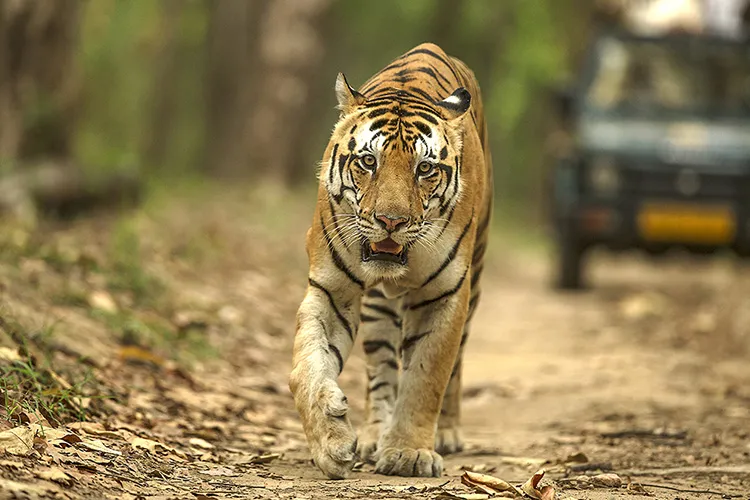
Luxury Tiger Safari with Golden Triangle Tour
14 nights/15 days.

Kanha, Bandhavgarh & Corbett Tour

Tiger Safari, Taj & Temple Tour
19 nights/20 days.
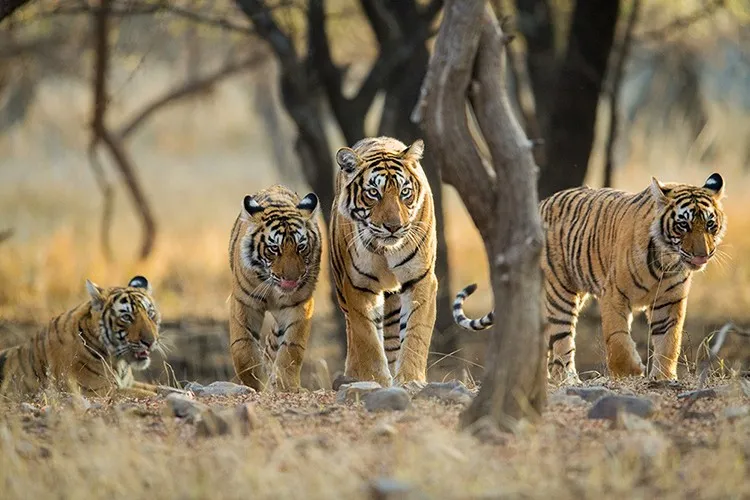
Luxury Tiger Safari and Cultural Tour in Rajasthan
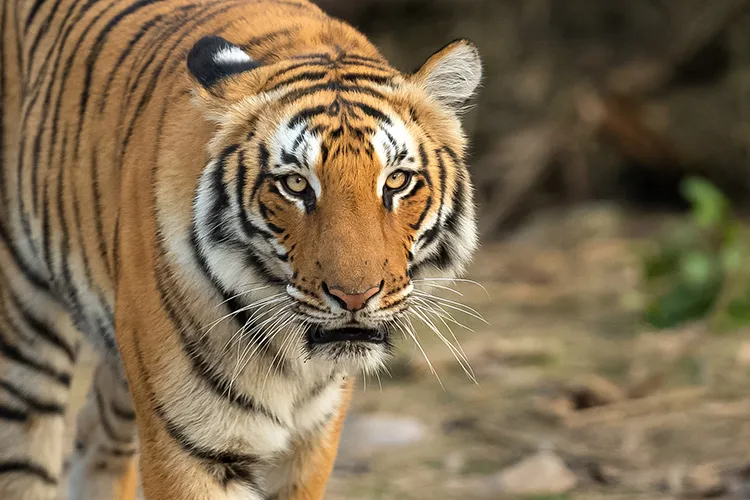
Tiger Safari in Corbett National Park
04 nights/05 days.

Tigers & Other Wildlife
The red panda and tiger safari tour, 10 nights/11 days.

Tiger Safari in Bandhavgarh National Park
05 nights/06 days, bespoke tiger safari india tours, tailored wildlife adventures.
Design your ideal wildlife expedition through India’s diverse landscapes. Select from a spectrum of national parks, tiger reserves, bird sanctuaries, and cultural marvels. Our expert team ensures every detail matches your preferences, from dietary needs, expert guides to transportation and language support. Let us curate the ultimate wildlife experience for you.
What all can be customized?
- Accommodation Preference
- Destinations
- Dietary Preference
- Transportation Options
- Special Interests
- Leisure Time
- Safari Vehicle
- Naturalist/Guide
- Photography Opportunities
- Nature Walks
Feel free to send us your customized requirements via the query form, or you can email us directly at [email protected] .

What you will experience with us.
Experience the best of Indian wildlife that includes the Royal Bengal Tigers , Asiatic Lions, Black Leopard, Indian Leopards, Snow Leopards, Red Panda, Asian Elephants a plethora of reptile and bird species, with experienced naturalists while you stay at the best-selected premium wildlife lodges and hotels.
More Reasons to Choose Tiger Safari India
Tiger Safari India, where the wilderness comes alive and unforgettable adventures await you. With over 30 years of experience and an unwavering passion for tigers & wildlife , we are renowned as one of the most trusted wildlife tour operators in India.
At Tiger Safari India, we specialize in creating extraordinary wildlife experiences, meticulously crafted to immerse you in the mesmerizing beauty of India’s diverse ecosystems. Our team of professional and experienced naturalists are dedicated to ensuring that every moment of your wildlife journey is filled with wonder and discovery .
We take immense pride in our handpicked selection of top-notch wildlife lodges and accommodations, carefully chosen to provide you with the utmost comfort and a seamless blend with nature . From luxurious jungle resorts to eco-friendly wilderness camps, we ensure that your stay is both enchanting and rejuvenating.
Seamless transport is a cornerstone of our service, as we understand that getting you to the heart of the wilderness is the first step to creating a remarkable wildlife experience. Our well-maintained vehicles and expert drivers ensure a safe and comfortable journey, allowing you to soak in the breathtaking landscapes along the way .
Tiger Safari India has earned the admiration and appreciation of thousands of guests from around the world. Our commitment to delivering exceptional wildlife encounters has made us a preferred choice for wildlife enthusiasts, professionals, and photographers seeking thrilling encounters with India’s iconic Bengal Tigers & other wildlife creatures.
We are renowned for our expertise in organizing tiger, leopard, snow leopard, Asiatic lion, red panda, and sloth bear safaris in India . Whether you aspire to witness the majestic tigers of Ranthambore, the elusive snow leopards of Ladakh, or the regal Asiatic lions of Gir, our carefully curated itineraries will take you to the heart of these incredible habitats.
At Tiger Safari India, we believe that every journey should be a once-in-a-lifetime experience. With our deep understanding of wildlife behavior and a commitment to responsible tourism, we ensure that your encounters are respectful, ethical, and unforgettable .
Embark on a transformative wildlife expedition with Tiger Safari India and discover the magic of India’s rich biodiversity. Let us create a tailor-made itinerary that fulfills your wildest dreams and leaves you with cherished memories that will last a lifetime .

The best destinations for Tiger Safaris in India
Top national parks to catch the big cat in action...
There are over 600 national parks in India which are home to close to 200 endangered mammal species. The Royal Bengal Tiger is one of the flagship species as not only is it the apex predator of the very forests that thrive here, but it is also the biggest cat among its brothers. National Parks in India varies with varying tropics and landscapes. We have the dry deciduous forest of Ranthambore National Park in the western part of India while the evergreen Sal forest of Kanha National Park thrives in Central India. Corbett National Park is unique as it rests in the foothills of the Great Himalayan Range, making it an awe-stunning frame to capture. India has some of the most biodiverse lands making it a hotspot for wildlife and tiger safaris and nature enthusiasts.

- Bandhavgarh National Park
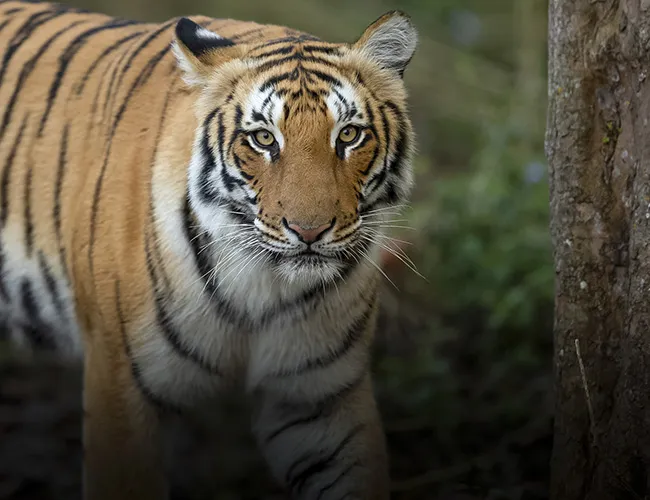
- Corbett National Park

- Kanha National Park

- Ranthambore National Park

- Tadoba National Park
Exclusive Tiger Safaris in India
On trails that resonate his roar...
At Tiger Safari India it is our endeavor to provide you with the best tiger safari holidays in India that have learning, adventure, and unlimited memories. We encourage you to store your experiences in form of videos and still photos which you will fondly go over at a later stage in life with friends, families, and your future generations.
While it is easy to capture people, landscapes, and monuments, capturing wildlife involves certain dynamics. The wildlife documentaries by channels are made with painstaking efforts covering months of filming in unhostile terrain, expensive equipment, special permissions from the authorities, weeks of post-production, and a great deal of resources. The end result is a dream setup. But this is not what you always see when you are on a tiger safari .
The videos below are shot by our team during a safari using a regular video camera, in a regular safari vehicle, no tripods, no extra permissions, and importantly during a 3-night stay in a national park. This is how you see tigers during a wildlife safari .
Guest Testimonials and Experiences
Consistently rated as the best by our guests on TripAdvisor

Our efforts have time and again been recognized by all our guests on TripAdvisor. With reviews that are 100% genuine, you can read them here or head on to our official TripAdvisor page to browse through in detail.
Tiger Safari India FAQs
Frequently asked questions.
Among the many national parks in India’s golden Triangle Zone, Kanha National Park and Ranthambore National Park offer incredibly fulfilling tiger tours. You get to visit many breathtaking locations and can embark on numerous types of tiger safaris. Read our blog on the best tiger reserves in India for tiger safaris .
The Jim Corbett National Park currently houses over 350 tigers of varying species. It is one of the largest and most densely populated tiger reserves in India . The park is frequented by tourists and is a major attraction among wildlife enthusiasts.
To know more about tiger tours in Jim Corbett National Park, contact Tiger Safari India.
Tiger safaris in India actually happen throughout the year, but it is recommended to plan a safari tour between the cooler months of October and March. Each and every National Park in India has dedicated tiger safari zones that remain open to the public in longer durations.
It is important to plan your tiger safaris in India a good five months in advance, as it will give top tiger tour operators, like Tiger Safari India , ample time to prepare the best possible trip for you.
The Kanha National Park, Bandhavgarh National Park, Ranthambore National Park and Jim Corbett National Park are the four most visited and most popular tiger reserves. Each park also brings with it a unique tiger safari experience. Bandhavgarh Tiger Reserve has the maximum tiger population and hence the chances of sighting increases.
Avoid bright colors and instead, pick a wardrobe of nature-inspired shades like greens and browns. Camouflage printed outfits are also a good option. Heavy jackets for winters as the temperature is lower in the jungle.
The Corbett Tiger Reserve is considered the best place to visit for a tiger safari experience as it accounts for the most number of tigers by population (over 252 tigers and counting) as of 2022.
The state of Madhya Pradesh is home to the most number of tigers. On the other hand, Corbett National Park & Tiger Reserve ranks the top with tiger count of 252 as of 2022. Read our blog on the Top 5 Tiger Reserves with the Highest Tiger Population in India .
Enquire Now
Please fill the form below and our team will get back to you within 24 hours with a perfect tiger safari tour package.
Recent Blog Posts
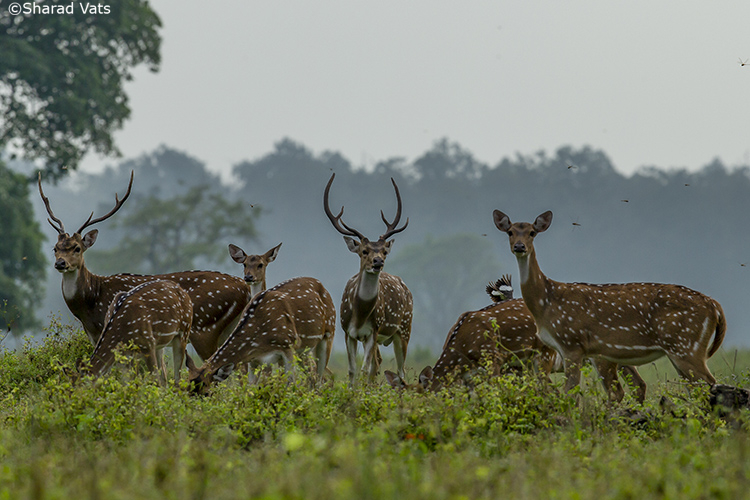
Why Conservation Matters – Preserving the Wildlife
Vibhav Srivastava

Exploring the Dietary Diversity – Diet of Indian Mammals
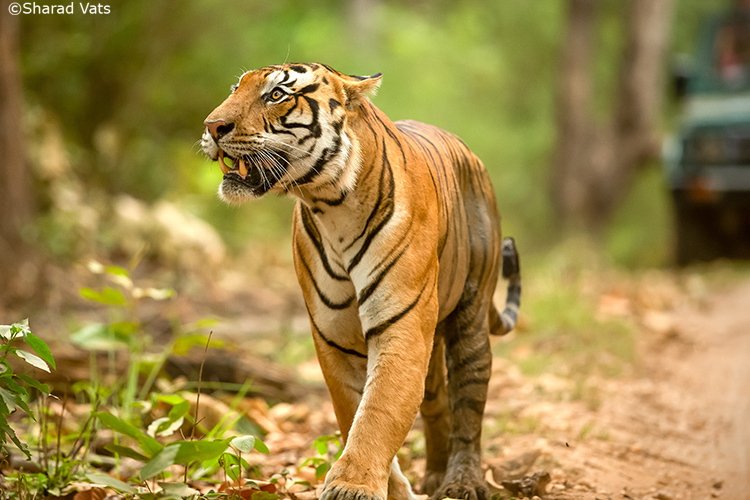
Top Five Wildlife Adventure in India You Must Consider
February 2024
107, A-3 Pocket, 106, 3, Sector 11, Rohini, New Delhi, Delhi 110085, India
[email protected] [email protected]
Sharad Vats : +91-9811200094
Tiger Safari Tours
- Kanha Bandhavgarh Pench Tour
- Kanha, Bandhavgarh And Corbett Tour
- Big Cats of India Tour
- Tigers, Lions, and Leopards Tour
- Tiger Safari in Ranthambore
- Tiger, Taj and Leopard Safari Tour
- Indian Wildlife and Rajasthan Tour
- Tiger, Taj and Temple Tour
- Just Tigers and Taj Mahal Tour
Tiger Safari Destinations
- Dudhwa National Park
- Panna National Park
- Pench National Park
- Satpura National Park
- Tiger Tour Packages
- TripAdvisor Reviews
- Safari Travel Guides
- Do's and Don'ts
- Testimonials
Copyright © 2023 Tiger Safari India (A Unit of Nature Safari India Pvt Ltd)
Partners and approvals

lokeshtardalkar
Travel,wild,craving,food,creating imaginations,outburst socially….dehydrated in urban india, outlandish…quest for perceptive selfism, embracing change: tigers as a sustainable tourism commodity in indian national parks.
Tiger tourism in Indian national parks has long been a double-edged sword. While it brings significant revenue, it also poses challenges to the conservation of these majestic creatures. The allure of spotting a tiger draws tourists from across the globe, making it a pivotal component of the local economy. However, the traditional approach to tiger tourism often leads to habitat disruption and stress for the animals.

A change in perspective is essential. Sustainable tourism practices must be prioritized to ensure the protection of tigers while still benefiting local communities. This includes regulating the number of visitors, promoting off-peak season travel, and enhancing tourist education on wildlife conservation. Encouraging eco-friendly accommodations and responsible safari practices can minimize environmental impact.
By fostering a deeper appreciation and understanding of tigers and their ecosystems, we can transform tourism into a tool for conservation. This shift not only safeguards the future of tigers but also ensures that the enchanting experience of encountering these magnificent animals remains available for generations to come.
#Research #WildlifeTourism #India Ministry of Commerce and Industry, Government of India TOURISM INDIA #Tourism #TourOpetator #Wildlife #Tiger #Commadity #BioDiversity
Share this:
Leave a comment cancel reply.

- Already have a WordPress.com account? Log in now.
- Subscribe Subscribed
- Copy shortlink
- Report this content
- View post in Reader
- Manage subscriptions
- Collapse this bar
Dazzling Panna
39.9 ℃ 10 Jun 2024
- Ghariyal, a huge reptile found only in the Indian Subcontinent, can be spotted at Ken Ghariyal Sanctuary
- Spot one of the highest waterfalls of India here
- Awarded best maintained national park of India in 2007 by Ministry of Tourism of India
- Was under the hold of founded by Maharaja Chhatrasal
- Out of the nine vulture species found in India, seven species are found in Panna.
While many of us are obsessed with tiger sightings, Panna National Park boasts of seven different species of vultures. Panna tiger reserve is an ideal place to spot these in their natural habitat. You will also come across a variety of flira and fauna here.
Panna has the amazing superpower to, both, calm you and thrill you! The royal past of this destination dates back to mid of 17th Centuary AD, when it became the capital of Maharaja Chhatrasal's kingdom.
For online Safari Booking at Panna National Park Click here To know more details about the Panna tiger reserve and places to visit in Panna visit the District Tourism Promotion Council websie : https://panna.nic.in/en/tourism /
Safari Booking: https://forest.mponline.gov.in For more details visit District Tourism Promotion Council website : https://panna.nic.in/en/tourism/
- Things To Do
Wildlife in Madhya Pradesh, India
The land of tigers and leopards. The home of Mowgli and the region with some of India's den
Different safari experiences to have in Madhya Pradesh
Madhya Pradesh is a paradise for wildlife lovers and the best way to discover national park
Panna- Things to do in and around Beyond a Tiger Safari
Panna the erstwhile capital of Bundela kingdom is famous for t
Things to do after seeing the Beautiful Temples in Khajuraho
When it comes to exploring the architecture and his
Panna National Park - The Gemstone of Indian National Parks
Old teak woods, indigenous colourful rocks, clear, pristine waters of the Ken River, the Vi
Panna's diamond mines were a boon
It is believed that when Maharaja Chhatrasal was going to battle the Mughals, he was given
Walk with Pardhis
Visitors of Panna Tiger Reserve can also participate in the walk with the Pardhis. Once a nomadic community that helped in hunting during Mughal era, have been hired to help tourists explore the buffer zone of Panna National Park. They are expert trackers and they can also mimic the voices of different animals with perfection. Read More
Best Places to visit
Ajaygarh fort, baldeoji temple, ken boating site, ken ghariyal sanctuary, mahamati prannathji temple.
View All Places Of Interest

Stronghold of the Chandela dynasty, this fort is perfect for the patrons of history buffs.?

Housing the idol of Shri Baldeoji in black shaligrami stone, this temple is built in Paladian style.

You can spot several migratory birds while you enjoy a lazy sail on the Ken river

Located at the bank of Ken river , it has colourful sandstone and granite.

During Sharad Purnima, Pranami pilgrims visit this temple, in which Swami Prannathji took Samadhi.

Mastani Mahal
Mastani was born to Bundela Rajput clan Maharaja Chhatrasal. She was born in Mau Sahaniya located around 15 km from district Chhatarpur of Madhya Pradesh. There is a Mastani Mahal in Dhubela where Mastani lived.
.jpg)
Pandav Falls
This 100 ft. high waterfall can be seen anytime throughout the year
.jpg)
Raneh Falls
Ken River forms a 98 ft. high gorge in the crystalline granite, giving you varying shades of pink and red to grey.
ACCOMMODATIONS

Madla Jungle Camp in Panna
Price: INR 2990 Phone: 9827749975, 07732-275275
View Details

Karnavati Retreat in Panna
Price: 2999 Phone: 8770429639/8109030121/9425301611
Restaurants And Bars
Bundeli bakhri, tribal cuisine.
Phone : 9810962562, 9669666939
Drawing inspiration from the ancient tribes of Madhya Pradesh, Orccha, Jhansi and Datia, the food is a tribal cuisine experience you are unlikely to forget.

Pinch Of Salt
Indian cuisine.
Phone : 99813 61106
Chef is also an artist and our chef proves it! Every served meal is a piece of art,come and enjoy your exclusive masterpiece!
Nearby destinations

Devout Chitrakoot (141 KM)
Boasting a spiritual legacy that very few cities in India can match, Chitrakoot is known to be of great religious and mythological significance. It is in the deep forests of Chitrakoot that Lord Ram

Graceful Khajuraho (43 KM)
Khajuraho is one of the most popular tourist spots in Madhya Pradesh. It is famous for its ancient temples that depict some of the finest art in the world. Built between 950-1050 AD by the Chandela
Travel tools
Destination map, local guide directory, tours and operators, destination brochure, tourist guides, best season to visit.
The best time to visit Panna is from October to April.
Tiger Eyes Tourism
- +91 9012825777
- [email protected]
- Ramnagar, Uttarakhand 244715

Phato Safari Zone
- Jhirna Forest Rest House
- Pawalgarh Conservation Reserve

Welcome To Tiger Eyes Tourism
Tiger Eyes tourism is a tour and travel operator in Ramnagar Uttarakhand. We provide all kind of adventure Jeep safaris booking, resorts booking, and activities in Corbett. At Tiger Eyes Tourism, we guide you at every stage of your tour with our services such as Jeep Safari, Caterer Safari, Camel Safari, Elephant Safari, Adventure Tour, Corporate Tour, and more. The sole aim of offering the best services at very affordable rates. Our motto and for that, we have been rewarded twice in 2017 and 2018 by Nagar Uttarakhand Tour and Travel Board. Our staff is ready to serve you 24*7 hours.
Corbett Online Booking
Adventurous safari @ corbett.
You can reserve a safari with a jeep from any provider of safari reservations in Corbett, but the things that distinguish Corbett Online from others are the good study of nature and wild animals, as well as our mission to preserve and protect natural resources. We will take you through the best picturesque views of the national park so that you can capture your memories for a lifetime with your camera. Our knowledgeable guides guarantee that during your safari in Jim Corbett, you will see majestic tigers that roam their natural territory. We have a large fleet of open jeeps, which have permission to enter through all the buffer zones of the Corbett.
Corbett Jeep Safari
- Max People:- 6 / Jeep
- Time:- Morning & Evening ( 4 hours )
- Departure:- Ramnagar
- Zone:- Bijrani, Jhirna, Dhela , Sitabani
Dhikala Canter Safari
- Max People:- 16 / Canter
- Time:- Morning & Evening ( 5 hours )
- Zone:- Dhikala
Corbett Sightseeing
- Max People:- 4 / Car
- Time:- Anytime
- Zone:- Museum, Garjiya Temple, Waterfall
Corbett is divided into seven ecotourism zones to ensure efficient monitoring of tourist activity. These zones are Bijarani, Dhikala, Dhela, Jhirna, Sitabani Durga Devi and Fato Zone. Each zone has its own natural appeal, with its scenic beauty and wildlife. The prime zone for tiger sightings is a great experience for animal lovers. Other animals such as spotted deer, wild elephant, roe deer, and barking deer are commonly seen in this area. The Canter Safari is a 16-person open-top bus safari organized in two shifts by the Corbett Tiger Reserve’s forest staff in all ecotourism zones. A limited number of safari jeeps are allowed in each zone to ensure an optimal distribution of visitors. Of all the tourism zones in Corbett, the Dhikala Zone is the most famous. You need to reserve your spot for the Canter Safari in advance and go to the entrance gate of Dhikala Zone to start the Canter Safari.
Adventurous Corbett Tour Packages
Corbett dhikala tour.
- Price: ₹ 7000 /Person
- Duration:- 1 Nights / 2 Days
- Safari:- Jeep Safari (2 Time)
- All Meals (Breakifast\Lunch\Dinner)
Corbett Nainital Tour
- Duration:- 2 Nights / 3 Days
- All Meals (Breakfast\Dinner)
- Availability Round The Year
Corbett Budget Tour
- Price: ₹ 5000 /Person
- Safari:- Jeep Safari
- Meals Only Breakfast
Corbett Group Tour
- Price: ₹ 1800 /Person
- All Meals (Breakfast\Lunch\Dinner)
Corbett Holiday Tour
- Price: ₹ 3500 /Person
Corbett Luxury Tour
- Price: ₹ 6500 /Person
Corbett is located in Nainital district is an ideal place for nature and wildlife lovers. It is a wonderful place in India, considered as the center of excitement and thrill. The entire park area is divided into four different zones called Bijrani, Dhikala, Jhirna and Durgadevi. Spread over an area of 520 sq km, the park is a complete package for wildlife lovers. However, tourism is only allowed in the designated areas of the Corbett maximize the chances of viewing the beautiful scenery and diverse wildlife that inhabit the park.
Jim Corbett Safari Zones
Bijrani safari zone.
- Price (Indian): ₹ 5500 /Jeep
- Price (Foreigner): ₹12000 / Jeep
- Timing :- Morning 6:00 AM - 9.00 AM | Evening 1:30 PM - 5:00 PM
Among the six safari zones, Bijrani zone is considered as the best zone after the Dhikala zone to spot the tiger. The picturesque landscape of this zone, which consists of large grass fields known as Chaurs and dense Sal forest, plenty of waterholes, and river streams is no less enchanting than the Dhikala zone.
Jhirna Safari Zone
Located at the southern edge of the Corbett Game Reserve, the Jirna Tourist Area offers exceptional opportunities for tiger and sloth sightings, as well as impressive views of the landscape. The Jhirna zone is mostly of dry deciduous type and consists of a large grassland (Chaur) area known as Laldhang Chaur.
Dhela Safari Zone
A forest of Dhela has the distinction of seeing seven tigers once in Corbett’s seventy-five years of history. This forest has mixed forest plantations and moist deciduous shelters for various species of wildlife including Sambhar Deer that attracts tigers as they get easy hunting.
Durga Devi Zone
One of the six ecotourism zones of the park, this zone is especially known for being the home to a large number of exotic birds. Literally, the zone is a paradise for bird-loving enthusiasts. Enriching the peaceful wilderness of this zone there are diverse species of wild animals are gracing this part of the Corbett forest
Garjia Safari Zone
Being limited safari seats, the Corbett administration has opened the Girija tourism zone for tourists. During peak tourism season many wildlife lovers get disappointed as they do not get a chance to enjoy the safari. However, the practice of opening a new zone was pending for a long time.
Sitabani Safari Zone
- Price (Indian): ₹ 5000 /Jeep
The Sitabani forest zone is called the landscape area, Sitabani is a hard forest area and not under the Corbett Tiger Reserve therefore the rules and regulations of CTR are not applied in this zone. Sitabani area has become a favorite spot for tourists walking because of its elaboration in the Hindu Epic Ramayana.
- Price (Indian): ₹ 1450 / Person
- Price (Foreigner): ₹ 2800 / Person
- Timing :- Morning 06:00 AM - 11:00 AM | Evening 11:00 PM - 05:00 PM
The ultimate safari experience maximizes the chance of seeing the majestic Royal Bengal Tiger resting in its natural habitat. Although a day visit to the Dhikala tourist area is not allowed except during the Canter safari tour which is organized by the Corbett Tiger Reserve management.
The Phato Zone is one of the well-known zones where the love of wildlife and the pleasant feeling of nature will give good vibes. Tigers are the key animal to be found in Corbett National Park. The Phato zone is uniquely beautiful and being here is another level of joy and enchantment.
Visitors can book online jeep safaris or safaris with cats for serven different zones of the park, namely: Bidjrani, Djirna, Dhikala, Dela Durgadevi and fato. All the procedures for booking safaris in Corbett are managed by the hill officials as per the instructions of the hill department of India. Please note that we cannot influence the safari zone, the safari driver and the naturalist guide, as this is not in our hands. This is decided only by municipal officials. Although all areas have healthy populations of tigers and wild animal sightings are reported more or less the same. All these aspects are controlled by an automated computerized system, to ensure an even distribution of the traveling vehicles in the respective zones.
Corbett Forest Lodge
Dhikala forest lodge, dhikala forest lodge accommodation & booking information.
The Dhikala forest complex consists of both old and new structures and is regarded as the unique accommodation amidst the large forest, one of the few of its kind. Old rest house in Dhikala owns the historical architecture, built by the British over hundreds of years ago.
Jhirna Forest Lodge
Accommodation in jhirna forest guest house.
Jhirna zone is one of the six tourism zones of India’s most illustrious tiger reserve, Jim Corbett Reserve Park. Located on the southern edge of the Corbett Reserve, the Jhirna zone is home to a wide variety of flora and fauna. Many years ago this place was a village that later moved elsewhere and the land was included in the reserve park.
Gairal Forest Guest House
Accommodation in gairal forest house.
The Gairal Rest House is the best forest house after the Dhikala Rest House in Dhikala zone. This place is a precious jewel, nestled cosily in the lap of nature, away from the hustle and bustle of the city. It is about 13 km from Dhangarhi, the gateway of the Dhikala zone and about 40 km from the city of Ramnagar.
Bijrani Forest Guest House
Accommodation in bijrani forest house.
Bijrani FRH offers you a night stay in the middle of the big forest in their beautifully built rest houses. This lonely forest residence consists of totally 6 rooms which consists of 4 double bed rooms and 2 single bed rooms along with 1 dormitory room consisting of 4 beds. Although this forest guesthouse is located in the forest for nearly 9 km from the nearby town of Ram Nagar, accommodation and food here are quite good.
Day visits to all areas are strictly regulated according to scientifically calculated capacity and only a limited number of vehicles are allowed to enter in the morning and afternoon. Permits for day visits to the Sonanadi Ecotourism Area can be obtained from the Visitor Reception Center located in Kotdwar. Permits for day visits to other areas are obtained online at our official website. We recommend visitors familiarize themselves with the visiting hours of the portal and arrive well in advance of the scheduled time to avoid any inconvenience. Private vehicles are “not allowed” to enter the park for tourism purposes, and visitors use specially designed vehicles registered with the CTR for this purpose. Day visits to the Dikala Ecotourism Zone are only permitted via specially designed Canter buses through Ramganga Conducted Tours. Visitors can also take advantage of an elephant ride in the Bijrani and Dhikala Ecotourism Zone, which is offered on a first-come, first-served basis. Canteens are available at Dhikala, Bijrani, and Gairal. Kitchen facilities are provided elsewhere.
Bijrani Forest Holiday House : Bijrani is one of the most significant areas of the Corbett . Bijrani There is a state forest rest station in this area that allows overnight stays in nature. The area in Bijrani was once dedicated to a shooting range during the British period. The area was much loved by bushmen as it offered quality game hunting. As for Bijrani’s terrain, it is drier and has more diverse vegetation compared to Dhikala.
Gairal Forest House: This holiday home can be reached by a short detour from the main Dhangarhi-Dhikala Forest Road. The main attraction of this rest station is that it is located on the banks of the Ramganga River. Tourists staying here can enjoy a crystal clear, fast-flowing mountain river that flows through the pictures forests. Situated in the lap of nature, Gairal provides ideal conditions for observing nature and wild animals. picturesque surroundings and seclusion. A game drive to Malani is quite a worthwhile experience in nature as it gives an opportunity to observe various mammals and birds in their natural habitat.
Dhikala Forest House : Dhikala Forest Rest House doesn’t need much introduction if we talk about wildlife tourism in Corbett. This famous tourist destination is situated on the edge of the Patli Dhan Valley, through which the Ramganga River flows in multiple channels. Dhikala is an easy gateway to the different parts of the park. The place offers a panoramic view of the valley with the Kanda Range in the background. The old forest rest station in Dikala is a historical building built more than a hundred years ago.
Jhirna Forest Rest House: Jhirna is also a well-known forest lodge located right on the southern border of the park. If we move from Ramnagar to Kalagarh road, which runs in the east-west direction of the park, Jirna is located on this road. If we talk about the landscape, it is drier compared to that of Dhikala and the vegetation is mostly scrub. The area in and around Jirna was an agricultural village until 1994 when it was successfully relocated under the Tiger Project. This important Corbett area is good habitat for the tiger, elephant, deer, and interesting mammals such as the sloth bear and the wild boar. Visitors can enjoy bird watching as many species of native and migratory birds can be seen.
Corbett Hotels & Resorts
Corbett is located in Nainital district is an ideal place for nature and wildlife lovers. It is a wonderful place in India, considered as the center of excitement and thrill. The entire park area is divided into four different zones called Bijrani, Dhikala, Jhirna and Durgadevi. Spread over an area of 520 sq km, the park is a complete package for wildlife lovers. However, tourism is only allowed in the designated areas of the Corbett Tiger Reserve to maximize the chances of viewing the beautiful scenery and diverse wildlife that inhabit the park.
Manu Maharani Resort
- Dhikuli, Jim Corbett National Park
- Air conditioning
- VIP room facilities
- Family rooms
- Room service
Aahana The Corbett
- Sawaldeh, Jim Corbett National Park
- Fitness Centre with Gym
- Bar / lounge
Samsara the Resort
- Kanchanpur, Chhoi, Corbett National Park
- Children Activities
- Bridal suite
Corbett Jungle Treasure
- Airport transportation
- Conference facilities
Jim's Jungle Retreat
- Dhela, Jim Corbett National Park
- Yoga classes
- Bicycle rental
- Smoking rooms available
Sterling Corbett Resort
- Marchula, Jim Corbett National Park
- Soundproof rooms
Do's & Don'ts
Do's in corbett:.
- Permits are necessary for entering the Corbett Tiger Reserve so please enter the park only after getting the permit
- Tourists are required to carry a litter bag while entering the park and bring back their non-biodegradable garbage like plastic, bottle, metal foils, tin can, etc. Outside the park
- Get an official registered Nature guide that will help you in spotting wildlife and ensuring that you do not lose your way in the forest
- Wild animals are the actual asset of the park, respect and maintain a safe distance from them
- Listen to the melodious music of the forest instead of your stereo
- It is advisable to wear clothes of colors which merge with the natural surroundings like khaki, olive green, and some other dull colors
- Please switch off lights, fans and water taps when not in use
- It is compulsory to obtain a clearance certificate before leaving your place of residence within the Tiger Reserve
- A maximum of two adults and two children (below 12 years) per room is allowed to stay in the tourist zone, so arrange your excursion as per the availability of rooms
- Drive slowly
Don'ts in Corbett:
- Do not carry any kind of firearms within the Tiger Reserve, it is strictly prohibited
- Smoking and lighting any kind of fire is strictly prohibited within the Tiger Reserve
- Driving after sunset is strictly prohibited inside the reserve
- Cooking is not allowed inside the National Park
- Do not play any kind of transistors and tape recorders
- Do not take your vehicles off the designated routes thereby causing damage to plant or animal
- Do not blow horns and driving above the speed limit is strictly prohibited
- Take care of zones as entry into the restricted zone by visitors is prohibited
- Shouting, teasing, or attempting to feed animals are prohibited and will invite severe penalties
- Non-vegetarian food is strictly prohibited within the Corbett Tiger Reserve
- Do not enter the National Park after the sunset
- Your permit to the National Park is non-transferable so do not try any kind of unfair means

Fill The Reservation Form
Photo gallery.

TourismTiger uses cookies to give you the best possible service. If you continue browsing, you agree to our use of cookies. More details can be found in our privacy policy .
The Power of Storytelling: How To Improve Your Tour Experience
Being a tour operator is challenging work. You and your guides (opens in a new tab) need to be intimately acquainted with the sights and locales you accompany your group through, while also taking their safety and satisfaction into account. This is where being a good storyteller comes into play. Great storytelling will help attract more customers to your agency and make the overall guest experience a positive one.
Based on published data (opens in a new tab) , 92% of people admit to trusting word of mouth over traditional marketing, while 75% of marketers still fail to embrace storytelling. Tourism is primed for storytelling, and as such, we can discuss the different ways this can be implemented into your tours.
Storytelling Traits You Should Embrace
Who doesn’t love a good story? But when it comes to tours, storytellers need the ability to come up with relatable and engaging tales for their groups. There are certain traits that you should consider cultivating further to improve your or your guides’ storytelling skills:
Interact, listen, and engage – Your customers will always come on a tour with certain expectations, prejudices, and goals. Listen closely, and you will know which buttons to push to make their tours more engaging. By paying attention to their interests you can adapt your approach and provide a certain level of tailored information.
Show your humanity – Tour operators and guides should be casual and friendly toward their customers. Smile, make eye contact, and talk as if you would with a close acquaintance to brighten the mood. Tone is crucial in storytelling.
Always have a point – Every story you tell, whether verbally or through online presence whether that be on your website (opens in a new tab) or online marketing (opens in a new tab) , should have a point. Ideally, you can also indicate a key takeaway or fact during a stop, or a call to action for your customers to follow up on afterward. For example use the story of how you started your business, or particular values your company holds to create that initial connection with your customers before they even take your tour by convincing them to book with you. After your tour, aim to collect feedback, reviews, or have customers sign up to your mailing list or follow you on social media.
Be decisive and unwavering – As a tour operator, your job is to take care of the group you are in charge of. (opens in a new tab) Communicate with your guides so they know and implement the rules that you’ve set so they can take the necessary actions if anyone is not following safety procedures and maintain the safety of your customers as well as their own.
The Tour Operator/Guide as the Anecdotal Historian
Whether you’re going on a trip to another country or a local wildlife reserve, you should keep the customers’ perception of you in mind. People see tour guides as authority figures, and like it when guides take charge and discuss interesting sights or historic tidbits to take notice of. Tour guides are inherently a form of an anecdotal historian, someone with the knowledge of how or why a certain historic sight exists, for example.
On the other hand, customers can sideline you with unexpected questions and ask for explanations in front of everyone, so proper preparation is a must. As such, you should always arm yourself with knowledge about the place you are about to visit with your group. As a storyteller, you will be able to weave historic facts with current trends and lingo to make for engaging storytelling (opens in a new tab) . However, if you are not able to answer their question in that exact moment, offer to follow up after the tour, or even consider a special message in your post-tour email. This extra effort will not go unnoticed.
Making Use of Social Proof in Storytelling
In terms of making use of storytelling in the medium of digital advertisement, social proof (opens in a new tab) can and should find its way into your marketing materials. Luckily, tourism is an industry in which social proof in the form of testimonials, reviews, quotes, and other user-generated content such as photos content is abundant. Based on recent reports (opens in a new tab) , 93% of customers say online reviews impact their decisions, with 68% of respondents who trust customer opinions posted online.
Given how tourists are reliant on tour operators and tour agency word of mouth online, this can help your business attract more customers. Satisfied customers, other businesses you work with, and special memberships can all serve as your social proof. You can implement said social proof into blog posts, social media content, video ads, and other forms of advertisement in tandem with your storytelling skills.
Practical Storytelling Techniques
There are different ways in which you can implement storytelling into your marketing and verbal presentations. As with everything in life, it all depends on whom you are addressing. Depending on your customers’ profiles, you should try out different storytelling techniques and adapt them to your personality. Remember – being genuine is always better than being calculated, which is why mutual trust between you and/or your guide, and the customers is essential. Here are a few techniques for you to check out:
Starting with the Hook
Starting your presentation with a “shocking” hook that will grab your listeners’ attention and then going back to the beginning is a great storytelling technique. If you are on a tour through Rome, you can tell your group about more eccentric or unexpected facts of Ancient Roman or Renaissance life. Or present a surprising statistic. Locations are filled with exciting anecdotes that help take the standard facts of what happened to the next level.
Real-Life (Anonymous) Tourism Scenarios
Odds are that you are not on your first tour, so you will have catching stories to share. With customer confidentiality as a given, you can talk about experiences, questions, and impressions your past customers have made about the same places.
Don’t Simply Monologue
While it’s true that you or your guide are in charge, you should still give your customers a chance to shine and speak up. Create a set of questions before embarking on the tour and try to quiz them about the places you visit. Similarly, you can try to get to know them as people while in transit – we are all human after all.
Mix History and Myth in Storytelling
Let’s not kid ourselves – history by itself can sometimes be too dry. Whether you’re visiting The Parthenon in Athens or The Moscow Metro, you can always mix historic facts with folklore and myth. Whether or not the myths are true or not, their inclusion will create a more immersive storytelling experience for your group and showcase just how well-read you are. And more often than not, these fun anecdotes tend to be the points that visitors remember more than what year something was built.
The Art of Telling Stories
As we move deeper into the digital age of instant access to information or voice-search through our devices, pure unfiltered storytelling starts to matter. People who go on tours don’t want to hear regurgitated information that they could simply read online themselves or in the tourist guide they have in their pockets.
Tour operators and guides are in a unique position where they can shape their customers’ narrative experiences with their own silver tongues and a bit of creativity. Get a feel for the group you are working with before you start telling stories – the looks on their faces will speak for themselves. Injecting the right amount of performativity takes a great tour and turns it into a fantastic one. Ultimately storytelling is about the overall and memorable experience that you can provide your customers.
Find this article useful? Enter your details below to receive your FREE copy of 95 Epic Places To List Your Tours and receive regular updates from Tourism Tiger and leading industry experts.
By submitting this form, you agree to Tourism Tiger contacting you via email.
- Name First Last
- Business Type Aerial Playgrounds or Adventures Beach Activities Bike Tours or Rentals Boat Tours Flight Experiences Food Tours Multiday Excursions Nature Tours River Rafting or Canoeing Sightseeing Tours Snow Activities Transport & Transfers Web Design or Software Agency Other
- Country/Region Africa Australia Canada Caribbean China Eastern Europe France Germany Greece Italy Ireland Japan Latin America New Zealand Portugal Scandinavia South East Asia Spain Turkey United Kingdom United States of America Other
- Keep me updated!
No tiger found on the loose in Cincinnati after possible sighting reported, police say
CINCINNATI (WXIX) - Cincinnati police searched early Monday for a tiger after receiving reports from two people that one was possibly sighted near the Cincinnati Zoo and University of Cincinnati.
The first sighting was reported by people in a car on Martin Luther King Drive around 2:45 a.m., according to emergency communication reports.
About five minutes later, a frightened-sounding female reported a sighting outside Crosley Tower on UC’s campus off Martin Luther King Drive and Clifton Court.
She said she was calling from the Rieveschl Hall on College Drive. That building connects to Crosley Tower.
No tiger was ever located and no additional reports came in since, said Lt. Jonathan Cunningham, a police spokesman.
“We did receive a call for a possible sighting of something that resembled a tiger. So our officers did check the area with nothing found,” he said.
Both of the Cincinnati Zoo’s tigers, Zero and Jin, are accounted for, according to police and zoo officials.
“Our tigers are safe and sound at the zoo,” said Michelle Curley, the zoo’s communication director.
Officers also checked Burnet Woods off Burnet Woods Drive and Brookline Avenue.
During the search, police were ordered to stay in their cruisers.
Drones were put up to help the search, police confirm.
The search appears to have ended or dramatically reduced around 4:45 a.m.
It is illegal to own a tiger or any other dangerous wild animal in Ohio.
That law was passed in 2012 after several animals escaped from a private property in Zanesville.
The only exceptions are for those owned before the law took effect and permitted by the state.
See a spelling or grammar error in our story? Please click here to report it .
Do you have a photo or video of a breaking news story? Send it to us here with a brief description.
Copyright 2024 WXIX. All rights reserved.

Off-duty deputy shoots intruder after finding suspect inside his home, sheriff says

Changes coming to Cincinnati highways Monday, and your commute may be affected

NKY man dead in reported road rage shooting off I-71, police say

Serious crash closes SB I-71/75 for hours in NKY

6-year-old girl killed in freak badminton accident while on vacation with family
Latest news.

4-year-old girl dies after I-71/75 crash in NKY

Cincinnati Zoo takes precautions to protect its Asian elephant herd from a type of herpes virus
Second parent charged after toddlers, 7-year-old left alone in car outside cincinnati casino: court docs.

Bill Erpenbeck released from federal prison

Cincinnati Public Schools tightens student cellphone policy, pursues Yondr pouches

Similipal tiger reserve in Odisha to close for tourists from June 12
BARIPADA: The Similipal Tiger Reserve (STR) will be closed for monsoon from June 12.
The park will re-open from October 1. Regional chief conservator of forests and field director of STR, Prakash Chand Gogineni said the tiger reserve is closed from mid-June every year and re-opens from November 1. But it was decided to close the park early this year as monsoon is expected to arrive early in the state.
He said two entry points- at Pithabata under Baripada territorial division and Kaliani under Jashipur in the Karanjia division will remain closed for tourists.
“The staff of the respective forest divisions have been instructed to close the gates at the entry points. Besides, notice has been uploaded on the STR official portal for tourists,” he said.
While the park is closed, the Forest department will repair the roads within the park. This apart, infrastructure development work will be carried out in the park as per the official plan and direction of the government, the RCCF said. The closure of the park will also enable animals to mate in a peaceful environment to increase their population.
However, tourists will be allowed to book and stay the eco-tourism complex in the park, Gogineni said.

- nagpur News
Tourist observes a rarecoloration of eagle eyes

Visual Stories

Visitors at a nature reserve in India recently witnessed an incredibly rare sight, when a bear and a tigress confronted each other in a standoff that very nearly broke into a fight.
The scene unfolded in April at Pilibhit Tiger Reserve, a protected area in India's northern Uttar Pradesh state. Visitors on a safari filmed the encounter and posted a video to the social platform X April 30. The video shows a tigress ( Panthera tigris ) sauntering down a dirt road and then stopping in her tracks when a bear , which appears to be a sloth bear ( Melursus ursinus ), emerges from the trees ahead.
A rarest of rare sight of a bear charging towards a tigress, captured today at Pilibhit Tiger Reserve- A CATS( Conservation Assured Tiger Standards) habitat developed assiduously by UP Forest Department. Pl don’t miss the calm and composure of Big Cat even in face of attack &… pic.twitter.com/jU48UWpTqJ April 30, 2024
The bear wanders across the road and disappears behind long grass as the tigress watches. Moments later, as the tigress strolls on, the bear reappears and chases after her.
"A rarest of rare sight of a bear charging toward a tigress, captured today at Pilibhit Tiger Reserve," Rajiv Kumar Gupta , a retired government official with the Indian Administration Service who witnessed the encounter, wrote in the post.
In the video, the tigress whips around when she hears the bear charging after her, but she does not attack and instead stands her ground. After a few seconds of the two predators facing off, the bear retreats back into the trees.
Related: Huge cheetah that roamed China 1 million years ago would have stood face to face with a tiger
"Apex predators usually have a mutual respect for each other especially if they are of a similar size," Tara Pirie , a lecturer in ecology and conservation at the University of Surrey in the U.K. who was not on the safari at the time of the encounter, told Live Science in an email. "The tiger took time to watch the bear, sizing it up possibly to understand more about it. The bear did not show a particularly aggressive charge from the video so the tiger must have decided it was big enough to stand its ground."
Sign up for the Live Science daily newsletter now
Get the world’s most fascinating discoveries delivered straight to your inbox.
— Is the Javan tiger back from extinction? New study ignites controversy.
— Why are tigers orange?
— Indian giant squirrel: The 'rainbow' rodent that is also the world's largest squirrel
Predators of similar strength and size tend to avoid unnecessary fights, as fighting wastes energy and puts both parties at risk of injury, Pirie said.
In this case, the tigress may have been particularly reluctant to engage in a struggle because she was nursing three young cubs at the time of the encounter and could not "afford any injury," said Jitender Govindani , a professor and member of the academic council at ICBM School of Business Excellence in Hyderabad, India, who witnessed the standoff. Govindani noted the tigress appeared to surrender when the bear charged.
"The tigress lowered her guard and surrendered when the bear got into attack mode," Govindani told Live Science in an email. "Once the tigress surrendered the bear left immediately, as [it] was also not keen to fight and showed aggression just [to] show its readiness to take on the tigress head on if provoked to a fight."
Earlier in April, another tigress and her cubs ambushed and killed a crocodile in Ranthambore National Park, in India's northwestern state of Rajasthan. A video taken by visitors showed the four tigers feasting on the crocodile's carcass .
Sascha is a U.K.-based trainee staff writer at Live Science. She holds a bachelor’s degree in biology from the University of Southampton in England and a master’s degree in science communication from Imperial College London. Her work has appeared in The Guardian and the health website Zoe. Besides writing, she enjoys playing tennis, bread-making and browsing second-hand shops for hidden gems.
Watch tigress and her cubs feasting on crocodile they killed in rare footage
Is the Javan tiger back from extinction? New study ignites controversy.
1st Neuralink user describes highs and lows of living with Elon Musk's brain chip
Most Popular
- 2 100-foot 'walking tree' in New Zealand looks like an Ent from Lord of the Rings — and is the lone survivor of a lost forest
- 3 A 'new star' could appear in the sky any night now. Here's how to see the Blaze Star ignite.
- 4 Why did Homo sapiens emerge in Africa?
- 5 Blood Falls: Antarctica's crimson waterfall forged from an ancient hidden heart
- 2 James Webb telescope finds carbon at the dawn of the universe, challenging our understanding of when life could have emerged
- 3 Shigir Idol: World's oldest wood sculpture has mysterious carved faces and once stood 17 feet tall
- 4 What could aliens look like?
- 5 Neanderthals and humans interbred 47,000 years ago for nearly 7,000 years, research suggests

IMAGES
VIDEO
COMMENTS
Tiger tourism refers to the practice of visiting national parks and wildlife sanctuaries that are home to wild tigers, with the primary goal of observing and experiencing the majestic animal in its natural habitat. The main purpose of tiger tourism is to promote conservation efforts and raise awareness about the endangered status of tigers.
Common tiger tourism activities . There are two main tiger tourism activities: petting tigers and tiger selfies. Both of these are extremely damaging to tiger conservation. Petting tigers. In most cases, the tigers used for petting experiences are cubs that have been speed bred and removed from their mothers too soon.
The result: Visitors have a better chance of seeing — and photographing — a tiger, without causing harm in the process. Here, then, are 15 of the best — and most ethical — places to see tigers in the wild. 1. Bandhavgarh National Park, Madhya Pradesh, India. A Bengal tiger in Bandhavgarh National Park. (Photo by James Warwick/Getty ...
The confiscation of the tigers is a positive step in protecting these wild animals from the inherent cruelty involved in wildlife tourism. Only the removal of tigers will stop their exploitation and ensure that no further tigers will be bred for profit at the venue. In a shocking discovery, Thai wildlife authorities have recently uncovered ...
Increasing awareness of the animal's plight is one component of conservation efforts, and tiger tourism is part of this. It started slowly, but has grown greatly. Tiger reserves receive tens to ...
Captive wild animal encounters are hugely popular, thanks partly to social media. But our investigation shows many creatures lead dismal lives. For $10, tourists can pose with this tiger at Phuket ...
Tiger tourism can be a valuable tool for conservation and economic development, but it must be managed responsibly and sustainably. By prioritizing the welfare of wildlife, supporting local communities, investing in conservation efforts, and continuing to research and monitor the impacts of tourism, we can ensure a brighter future for tigers ...
Credit: Aravind Ramamurthy. A new study by the Centre for Wildlife Studies supports the idea that for tourists in India's nature reserves, tigers are the biggest drawcard. "Since nature ...
First declared a tiger reserve in 1978, the area is a testament to the progress that can be made through dedicated wildlife management and sustainable tourism practices. By visiting, you're contributing to local conservation initiatives aimed at protecting and preserving India's natural heritage and the majestic creatures that call it home.
It concludes that the consequences of contemporary tourism for the conservation of wild tigers are predominantly negative, even as tourism encourages the proliferation of captive tigers, and argues that without political will the problems engendered by tiger tourism cannot be resolved, even with the best professional advice. ...
Tigers Need Tourist Traps The best protection many endangered species have is tourism dollars. By Ralf Buckley. Oct 21, 2012 6:45 AM. A tiger is seen during a jungle safari at the Ranthambore ...
For example, only 18 percent of reviews for tiger attractions, which received the lowest possible animal welfare rating, mentioned concerns about the welfare of the animals.The other 82 percent of ...
Tourism Tiger designs travel & tourism websites that are effective from day one, and our ongoing updates ensure they stay effective. As dedicated tourism specialists, our focus has allowed us to develop the best possible website features for tour and activity businesses, creating tour & travel websites that look great and work for our clients and their own customers.
Sharon and Steve have been documenting the captive tiger tourism industry in the United States since 2016. Over the course of their undercover investigation, they exposed the dark underbelly of ...
Tigers and their majestic moods remain the star attraction in most national parks.-. The best solution to the problems relating to tourism in the core areas of tiger reserves will involve a balance between banning tourism there and allowing heavy tourism. OSCAR WILDE famously said: One can only give an unbiased opinion about things that do not ...
Ecotourism or sustainable tourism is an effective conservation tool. Recently increasing trends in visitations to protected areas (PAs) in India particularly, tiger reserves (TRs) have been documented. A questionnaire survey was carried out to objectively investigate visitor experience in three high profile tiger reserves (n = 684). Information on the role of nature interpreters, media and ...
The problem is rife in Thailand, where more than 50 facilities around the country hold in excess of 2,000 tigers, and around 2,700 elephants are kept in tourism "camps." All of these animals ...
Tiger Safari India, where the wilderness comes alive and unforgettable adventures await you. With over 30 years of experience and an unwavering passion for tigers & wildlife, we are renowned as one of the most trusted wildlife tour operators in India. At Tiger Safari India, we specialize in creating extraordinary wildlife experiences ...
Poorly-managed tiger tourism can create far-reaching problems. Research shows that forest authorities rarely have control over the quotas of tourists allowed into Indian national parks at any ...
7. Ceetiz. Why we love them: Ceetiz is gaining a lot of traction around the world. They are on the lookout for the best and most unique activities and make it easy for viewers to find activities that meet their interests, budget, and time requirements. How much they cost: Registration is free.
Tiger tourism in Indian national parks has long been a double-edged sword. While it brings significant revenue, it also poses challenges to the conservation of these majestic creatures. The allure of spotting a tiger draws tourists from across the globe, making it a pivotal component of the local economy. However, the traditional approach to tiger…
Panna tiger reserve is an ideal place to spot these in their natural habitat. You will also come across a variety of flira and fauna here. Panna has the amazing superpower to, both, calm you and thrill you! The royal past of this destination dates back to mid of 17th Centuary AD, when it became the capital of Maharaja Chhatrasal's kingdom.
Tiger Eyes tourism is a tour and travel operator in Ramnagar Uttarakhand. We provide all kind of adventure Jeep safaris booking, resorts booking, and activities in Corbett. At Tiger Eyes Tourism, we guide you at every stage of your tour with our services such as Jeep Safari, Caterer Safari, Camel Safari, Elephant Safari, Adventure Tour ...
Show your humanity - Tour operators and guides should be casual and friendly toward their customers. Smile, make eye contact, and talk as if you would with a close acquaintance to brighten the mood. Tone is crucial in storytelling. Always have a point - Every story you tell, whether verbally or through online presence whether that be on ...
"Our tigers are safe and sound at the zoo," said Michelle Curley, the zoo's communication director. ... Woman, teen injured in back-to-back shark attacks near popular tourist beach, reports say.
BARIPADA: The Similipal Tiger Reserve (STR) will be closed for monsoon from June 12. The park will re-open from October 1. ... However, tourists will be allowed to book and stay the eco-tourism ...
Tourist captures a rare condition of 'Heterochromia Iridis' in a juvenile serpent eagle at Tadoba-Andhari Tiger Reserve. Learn about this unique phenomenon and its implications on bird health and ...
843 likes, 10 comments - keralatourism on June 9, 2024: "Alert! Tigers on the prowl in God's Own Country! Hear the roars and the cheers as you prance around during ...
Visitors at a tiger reserve in India recently filmed an encounter between a tigress and a bear, with the bear charging after the tigress but deciding at the last minute it was not worth the fight.